ecosystem-guides.com
....exploring the planet's ecosystems
AFROTROPICAL
Tropical & Subtropical Savanna
This is it. The most famous and spectacular ecosystem in the world!
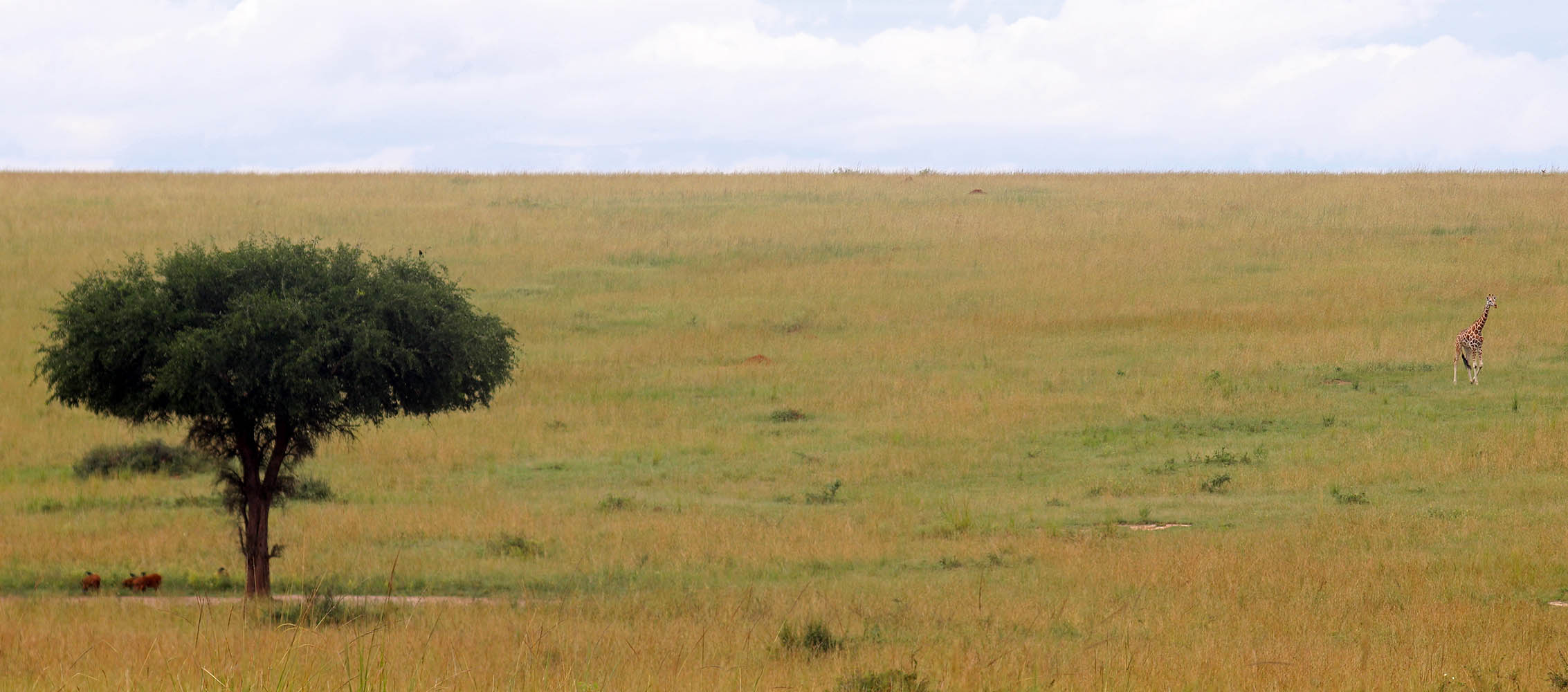 (Murchison National Park, Uganda)
(Murchison National Park, Uganda)This is what most people think of when they think of Africa and it's wildlife. This is the original savanna. For this definition, I am including all sorts of open woodland and grassland vegetation communities which I will divide up in the future. These habitats are found across tropical and subtropical Africa. Because many of us are focusing so much on the animals (particularly mammals) when we are in Africa, we tend to ignore the plants. However, many of these specific vegetation communities are usually based on dominant plant species, such as the Brachystegia dominated 'Miombo' woodlands, the Colophospermum 'Mopane' woodlands and the 'Acacia' Thornscrub savanna.
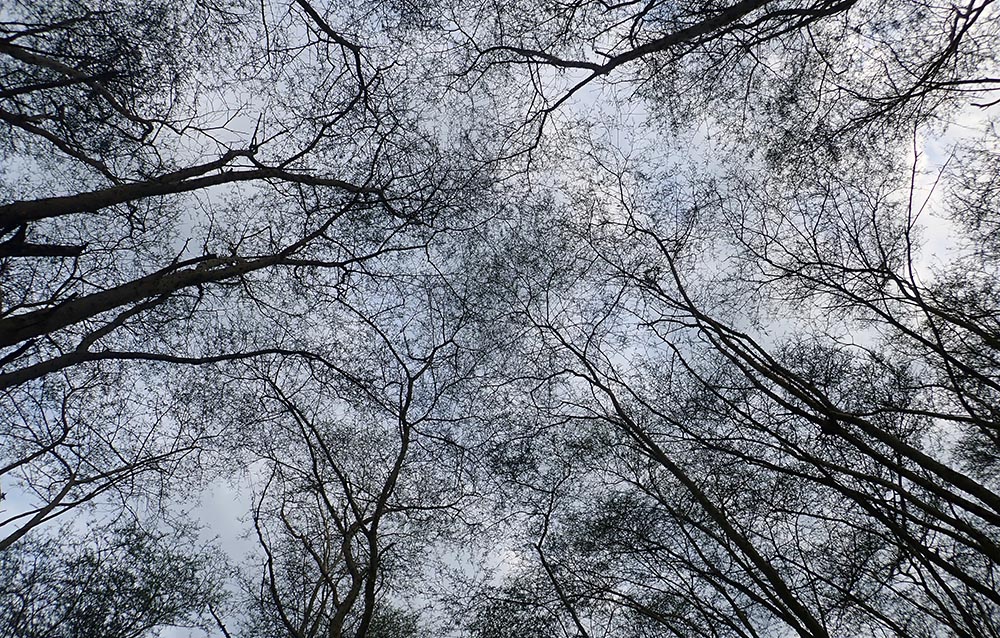 Unlike the rainforest, the trees in the open woodlands do not overlap to make a closed canopy.
Unlike the rainforest, the trees in the open woodlands do not overlap to make a closed canopy.Earlier this century it was decided to split the old genus of Acacia into several natural groups. Since the first species was named in the middle east, rules of nomenclature determined that the African Acacias retain the name, and the Australasian ones would be re-classified. However, because the majority of species in the genus are found in Australia, most of these would retain the genus name of Acacia, and the African species would have to re-name theirs. Sorry 'bout that!
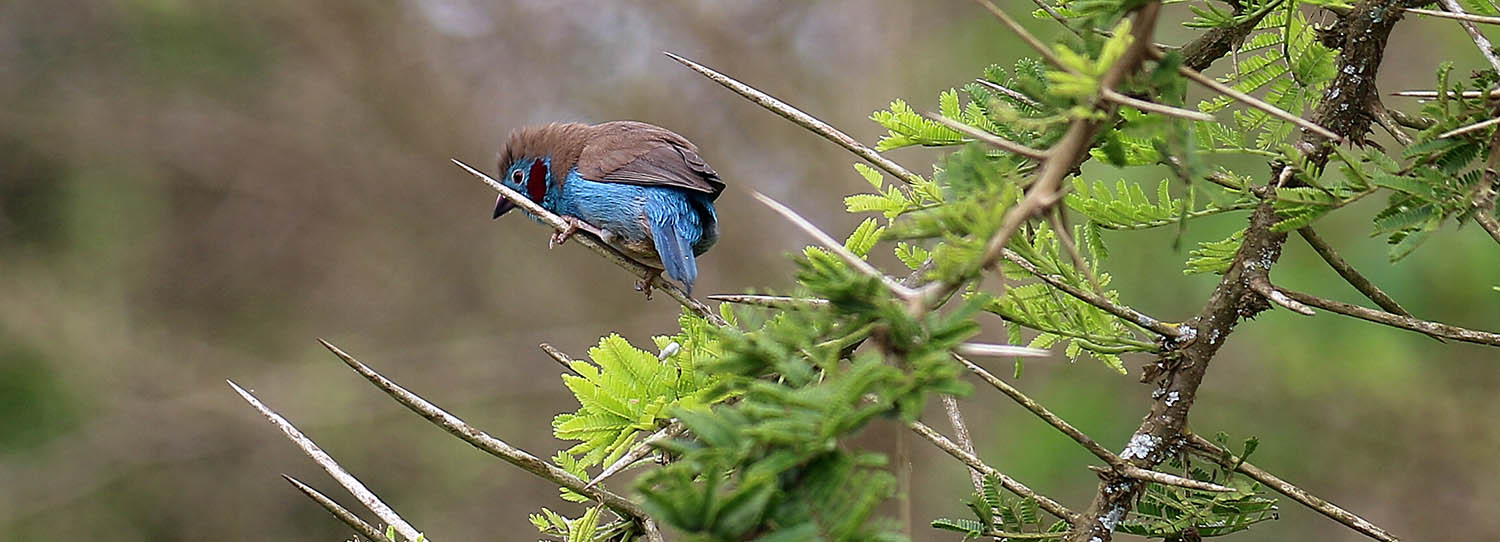
The family Euphorbiaceae includes half a dozen species of Euphorbia known as 'Candelabra' that grow as trees in open habitats of Africa. They are also called 'Cactus Tree'; with their thick spiny leaves, they superficially resemble cactus, although they are unrelated.
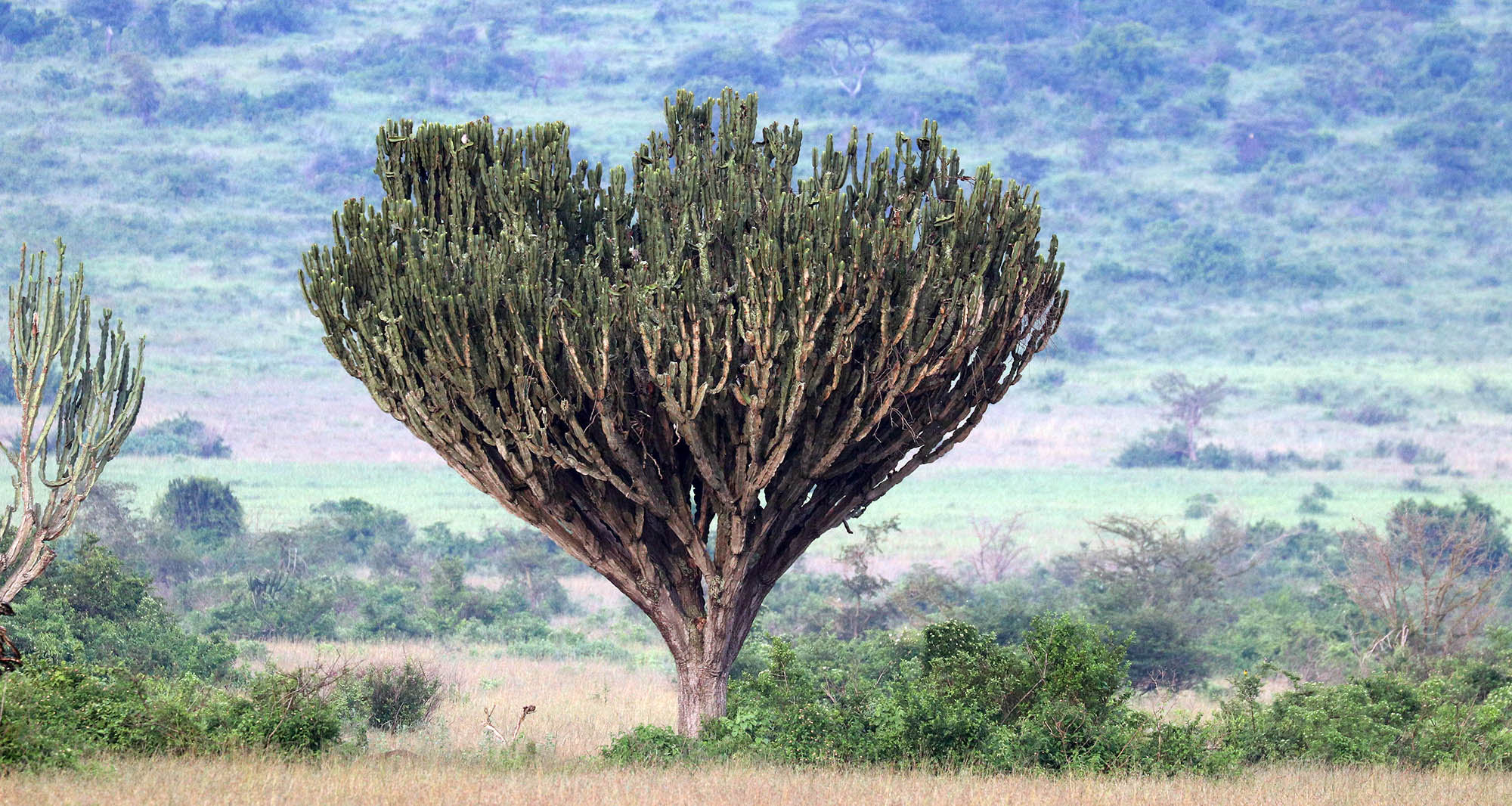 (Queen Elizabeth national park, Uganda)
(Queen Elizabeth national park, Uganda)Other flowers groups of the African savanna include:
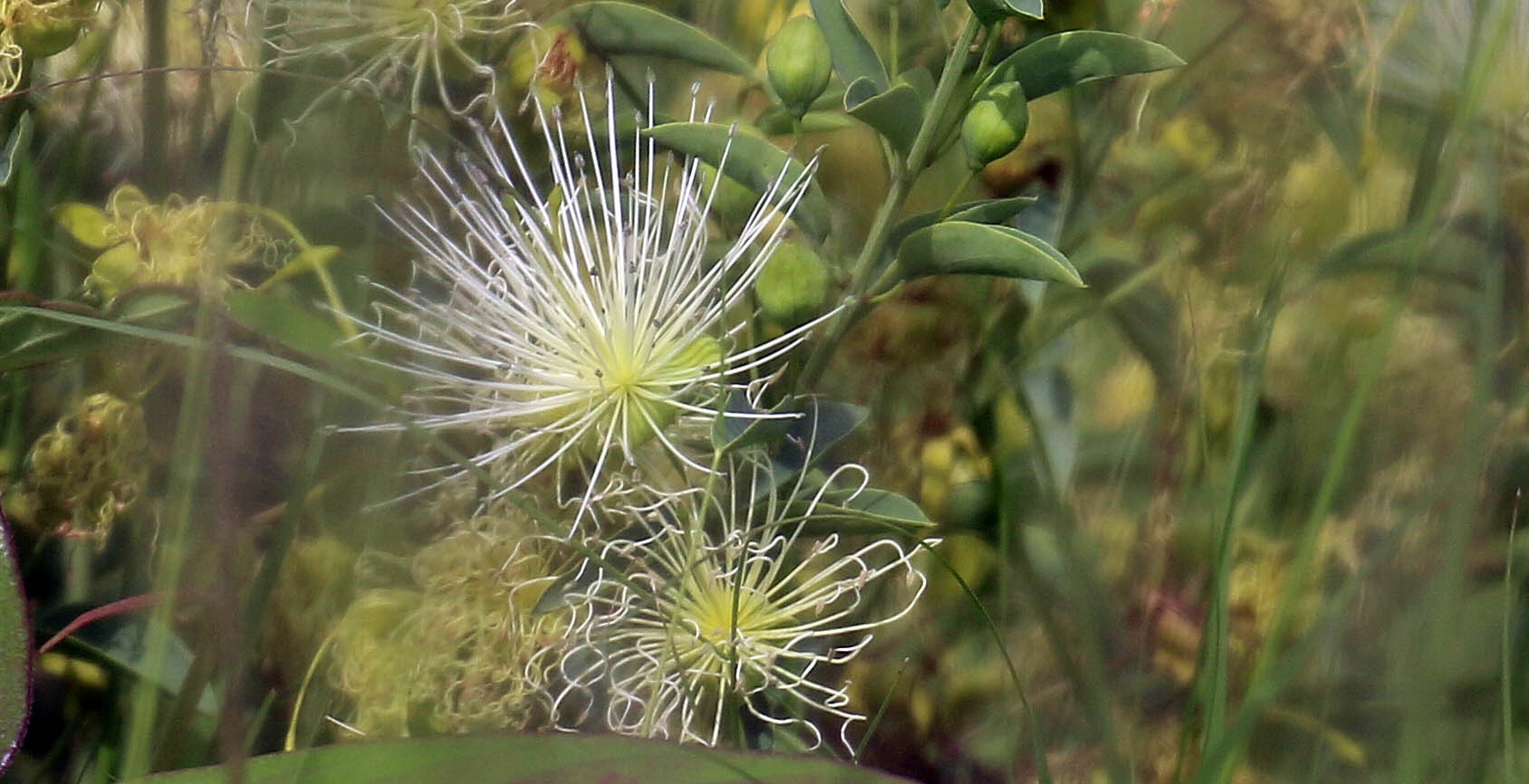 Capparis
Capparis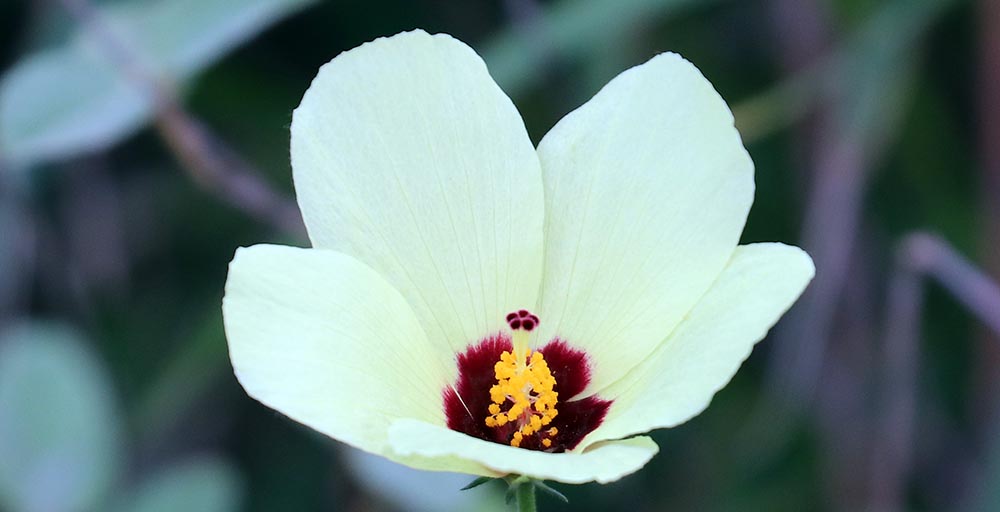 Hibiscus
HibiscusThe insect order Orthoptera: includes Crickets, Grasshoppers, Katydids and Locusts. Some of these species have transferred over to adjacent crops and become major pests.
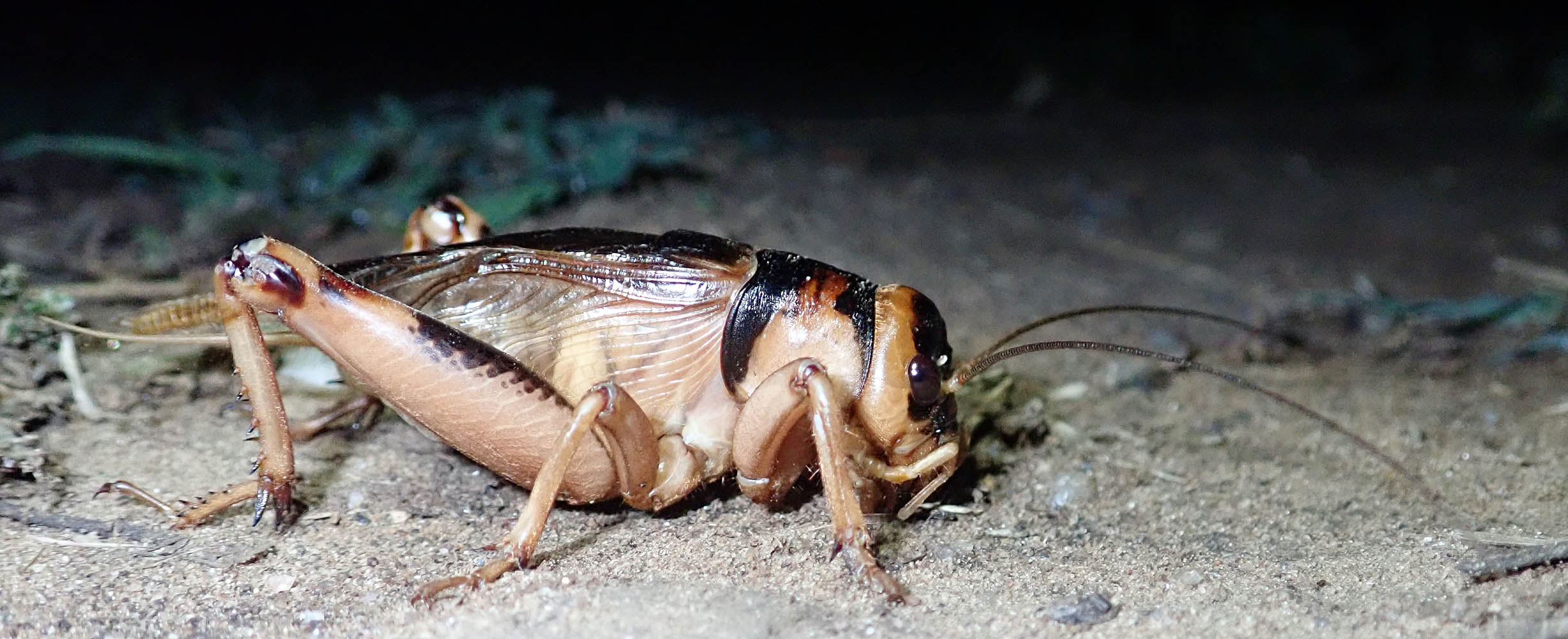 Brachytrupes membranaceus, 'Giant Burrowing Cricket', 'Tobacco Cricket'.(Queen Elizabeth National Park, Uganda)
Brachytrupes membranaceus, 'Giant Burrowing Cricket', 'Tobacco Cricket'.(Queen Elizabeth National Park, Uganda)The beetle order includes some small animals that capture the public interest just as much as the big animals in the African savanna. Here, species can often be seen rolling large balls of dung around the savanna, particularly noticeable when they cross the roads in game parks. They bury the dung underground and after mating the female will lay her eggs inside the faeces. The growing beetles feed on the dung, which provide all their nutrients and water. On the way to use the dung for their young, the adults determinedly roll their balls in as direct line as they can, which leads them to rolling them over all sorts of obstacles. There are other less obvious species of Dung Beetle that are not 'rollers', but 'tunnellers' and 'dwellers', these tend to dig into and live in the dung where they found it.
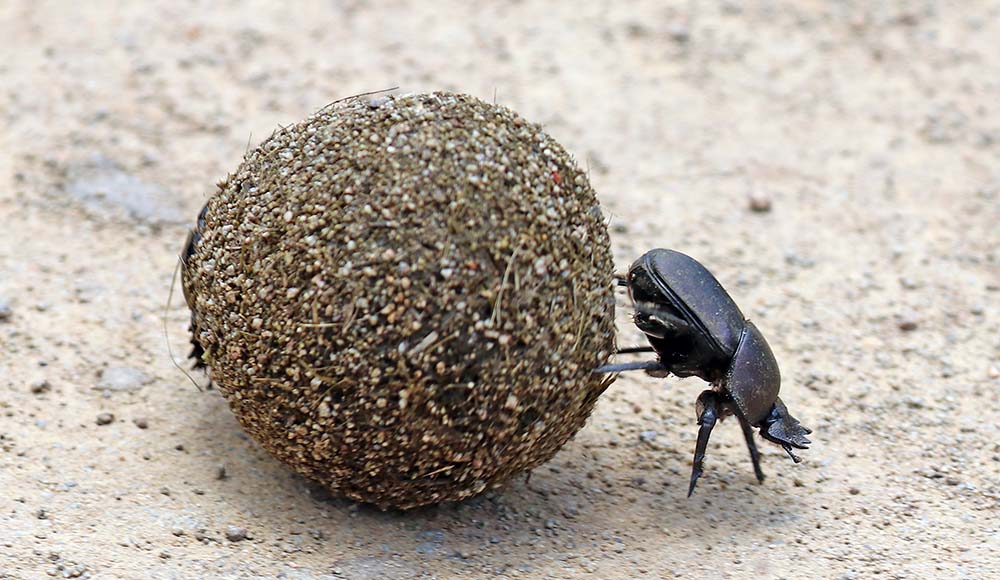 It's a shit job, but somebody has to do it! (Hluhluwe-Imfolozi, South Africa).
It's a shit job, but somebody has to do it! (Hluhluwe-Imfolozi, South Africa).Dorylus spp. 'Safari Ants', 'Driver Ants'. Often form long marching lines. The larger soldiers guard the workers and allow them a protected path to follow in between them. The columns move through the bush, including settlements, although they are easy to get out of the way of. The soldiers have large heads and mandibles; their attack is not so much with their sting from the abdomen like many other ants, but is through a bit from their strong mandibles. These are the ants that were infamously used as stitches in wounds for up to a few days by East Africans!
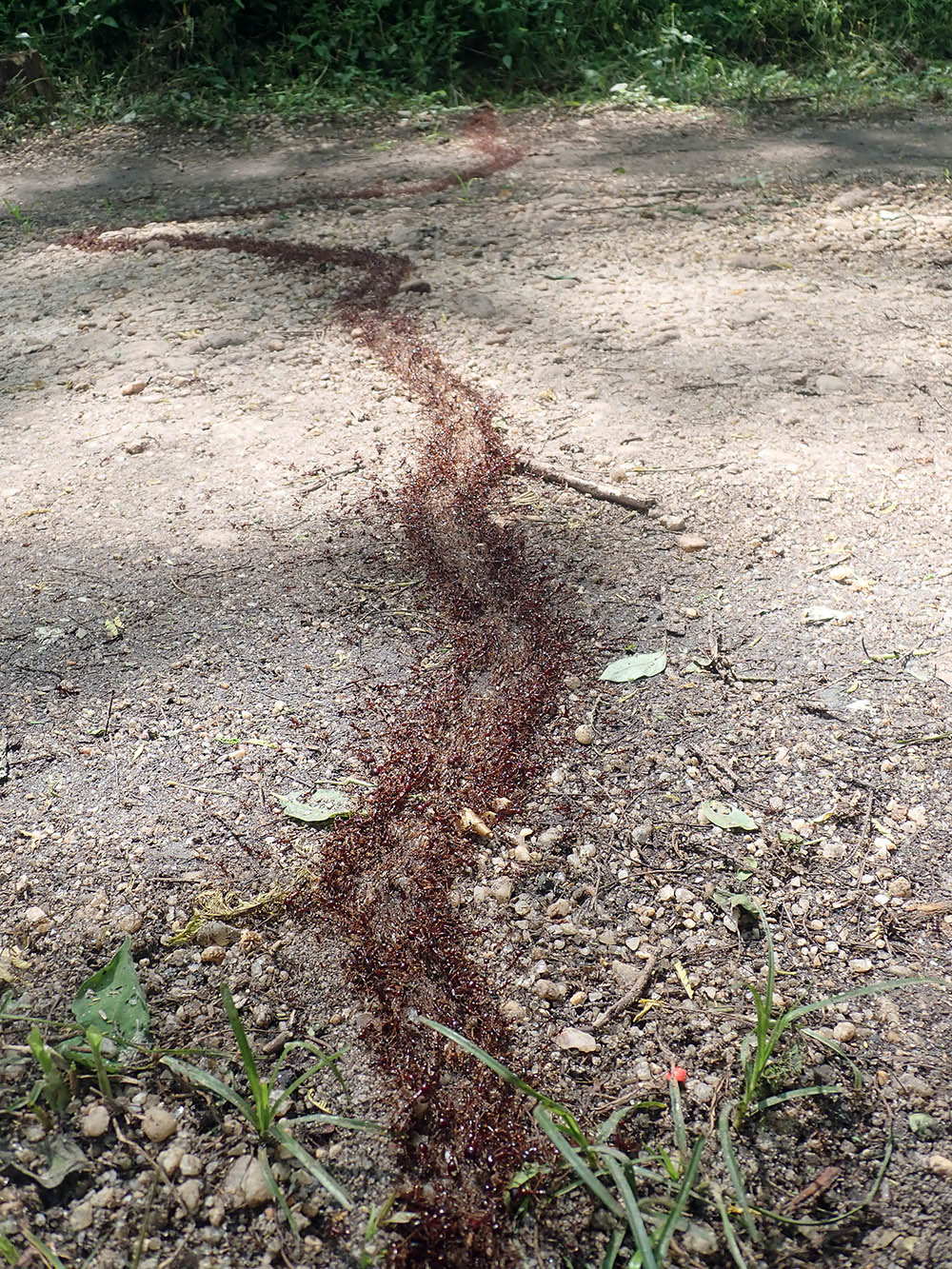
The Tortoises reach their highest diversity in southern Africa, where there are 14 species.
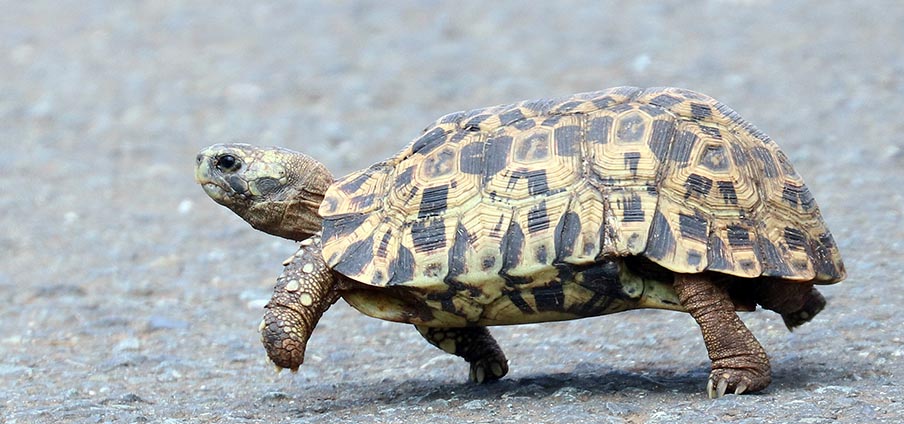 Hinged Tortoise, (Hluhluwe-Imfolozi, South Africa).
Hinged Tortoise, (Hluhluwe-Imfolozi, South Africa).Some of the most striking reptiles can be seen hanging about the game park lodges...
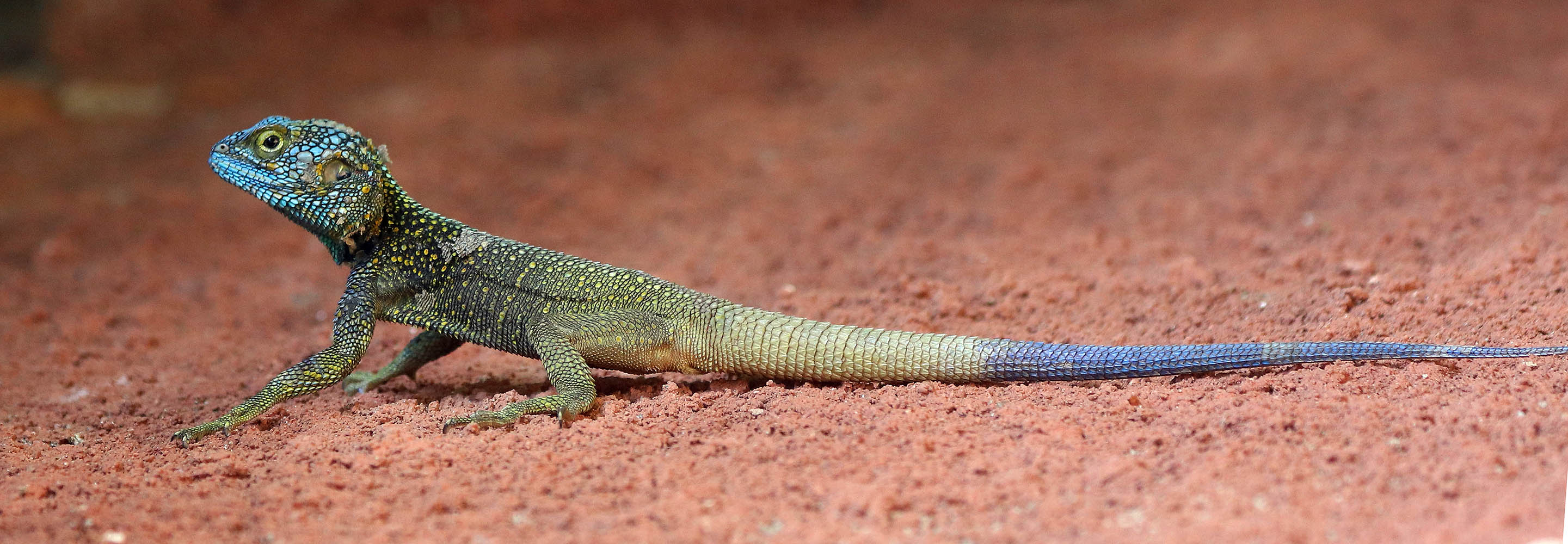 'Uganda Blue-headed Tree Agama' (Note: This image has been flipped to horizontal - Queen Elizabeth National Park, Uganda)
'Uganda Blue-headed Tree Agama' (Note: This image has been flipped to horizontal - Queen Elizabeth National Park, Uganda)...but also some of the more dangerous ones!
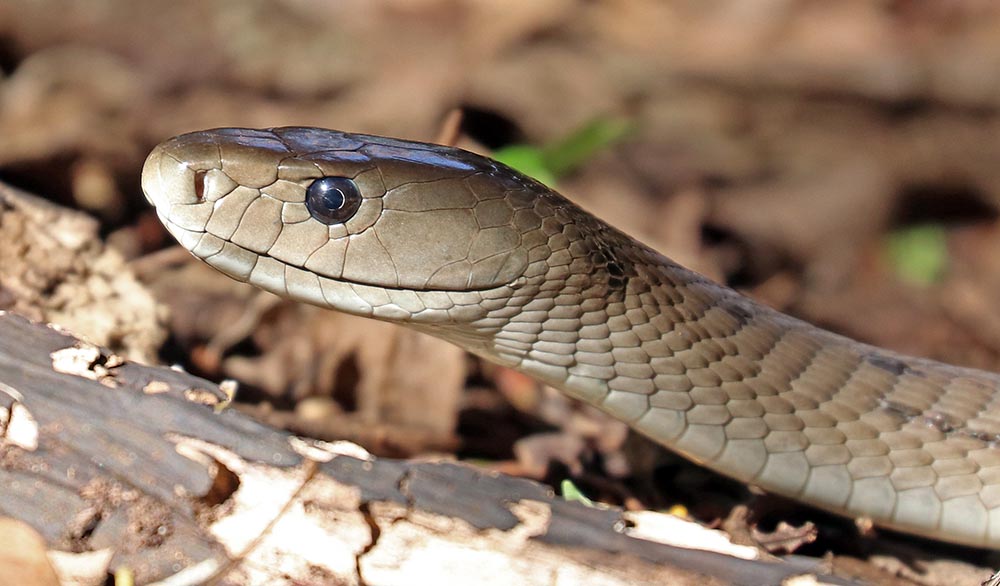 'Black Mamba', (Hluhluwe-Imfolozi, South Africa)
'Black Mamba', (Hluhluwe-Imfolozi, South Africa)While most people think of the great mammals when they think of African savannas, the birds are just as incredible. They are easy to see due to the open habitats, and the abundance and diversity is high. And they are just as easily seen around the lodges and campsites as they are on safari. Repeated trips will reward the visitor with new species.
The family Columbidae includes many species of open country savanna doves and pigeons
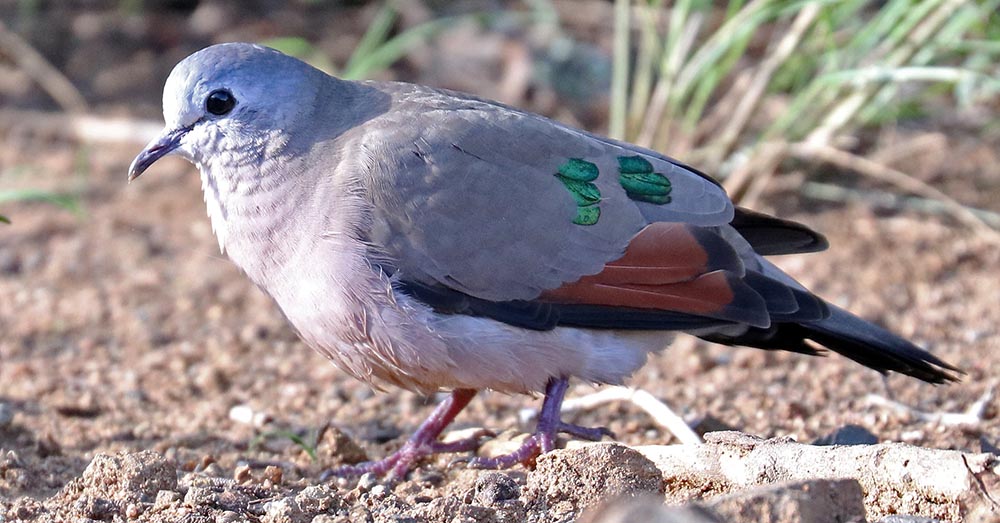 'Green/Emerald-spotted Wood Dove' (Hluhluwe-Imfolozi, South Africa).
'Green/Emerald-spotted Wood Dove' (Hluhluwe-Imfolozi, South Africa).The family Musophagidae is one of the few families endemic to the continent. It includes the Turacos.
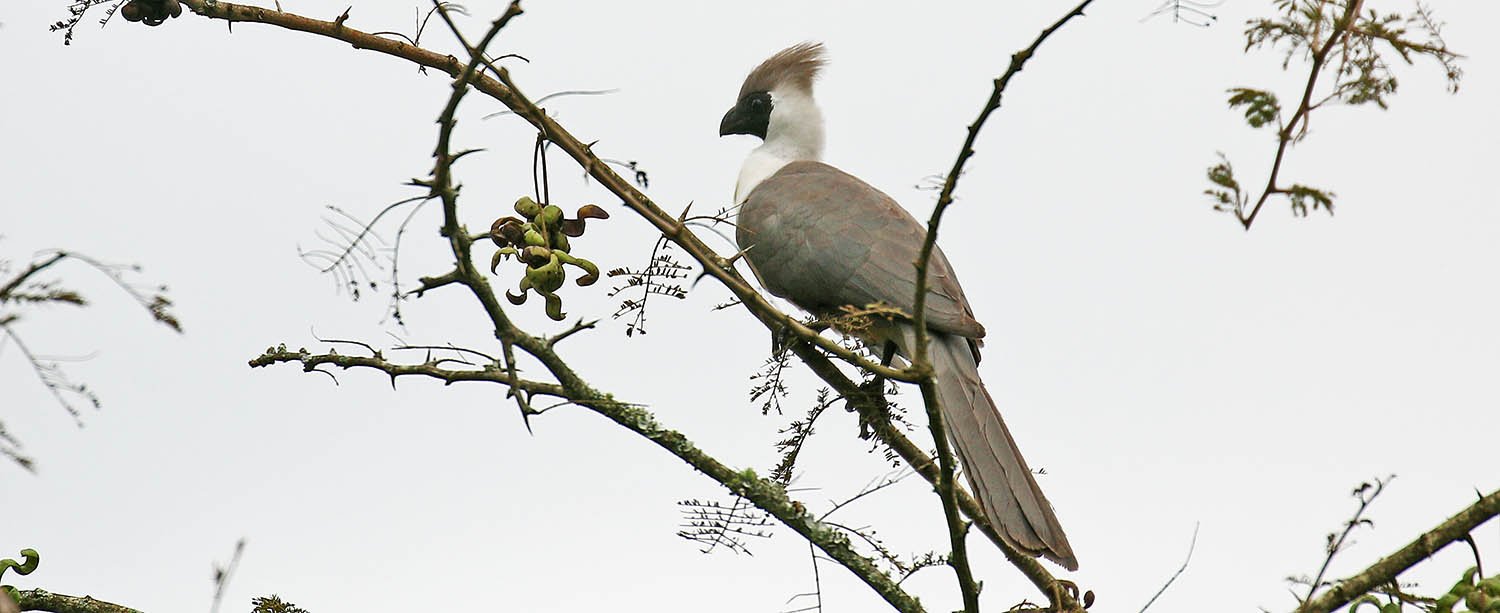 'Bare-faced Go-away Bird'
'Bare-faced Go-away Bird'There are many cranes in the open savanna and wetland habitats, including symbolic species such as:
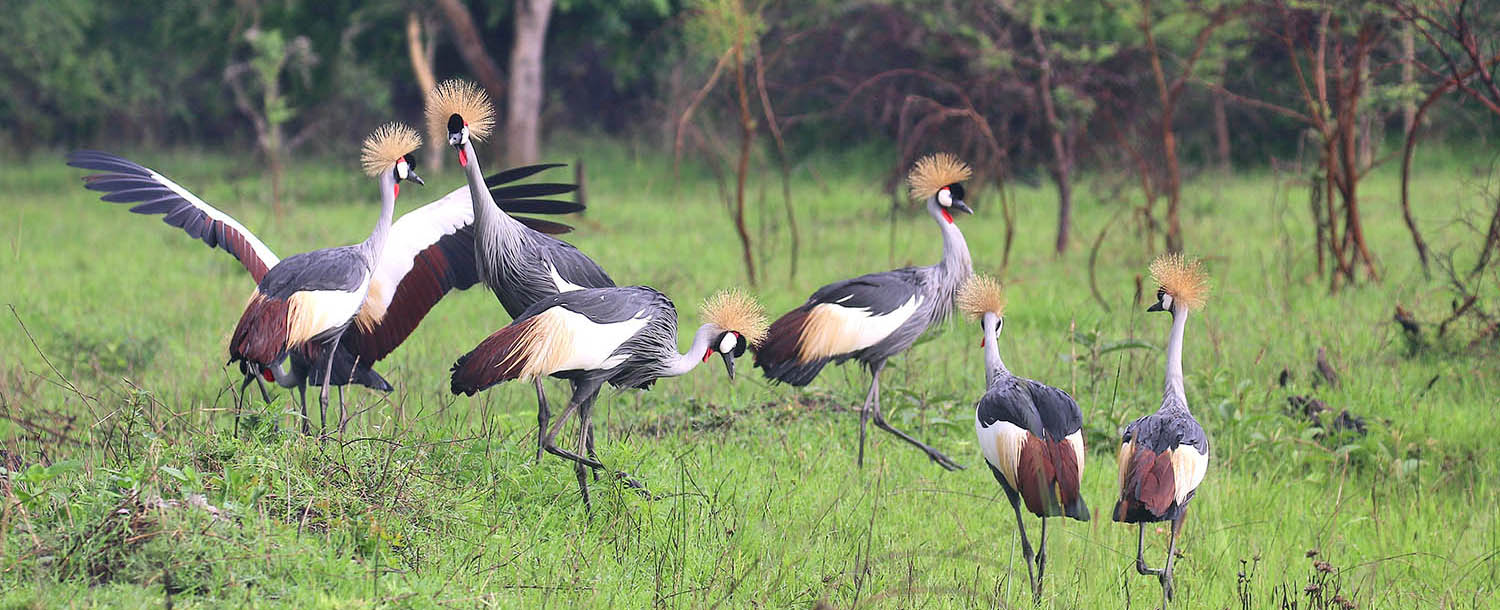 'Golden-Crested Crane' (Lake Mburo, Uganda)
'Golden-Crested Crane' (Lake Mburo, Uganda)The family Ciconiidae includes the 'Storks', and are well represented in African open habitats by some obvious and large species.
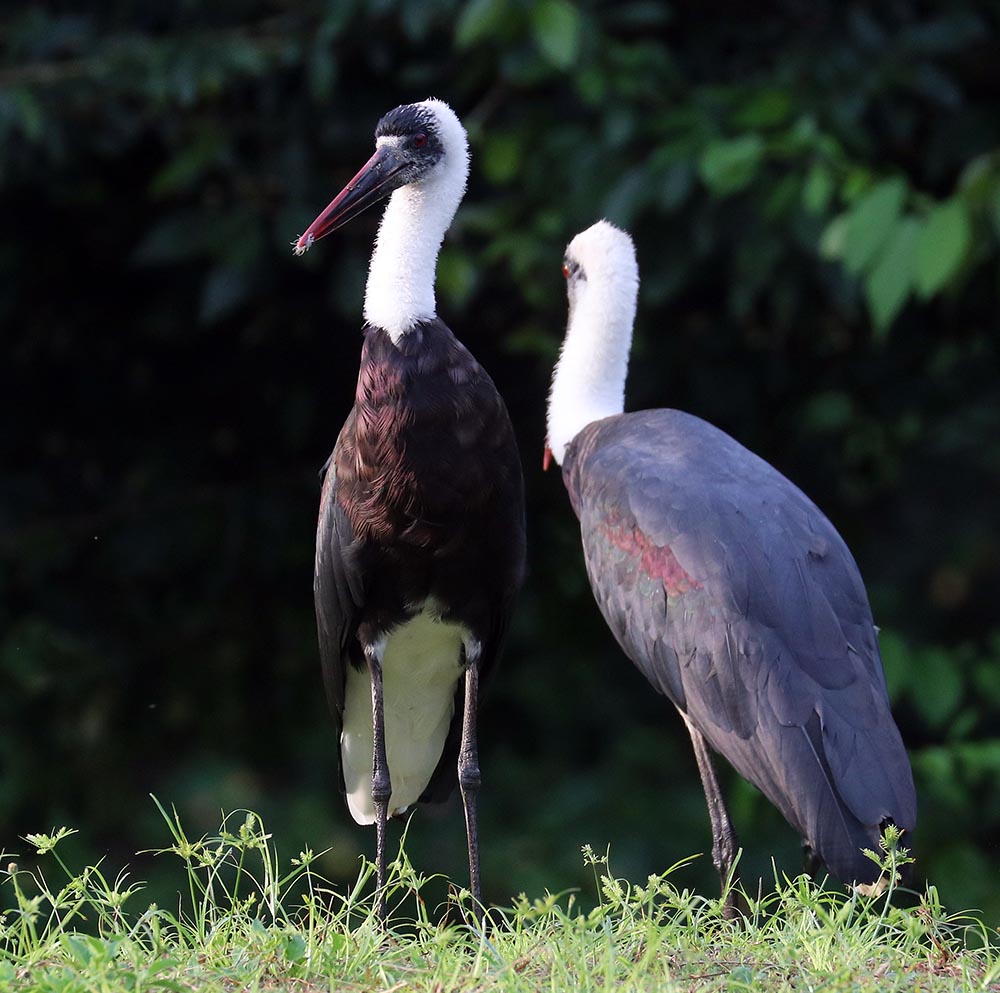 'Woolly-necked Stork' (Enjojo Lodge, Uganda).
'Woolly-necked Stork' (Enjojo Lodge, Uganda).With all the small mammal prey available across the savanna, birds of prey and diverse and obvious.
 'Long-crested Eagle',(Bigodi, Uganda)
'Long-crested Eagle',(Bigodi, Uganda)The endearing and cute 'mousebirds' belong to a family that is only found on this continent, and indeed even their entire order is endemic to Africa. They are usually plain brown in colour with patches of colour on the face and have long tails. They are most distinct by their habitat of crawling through the vegetation. This behaviour and their fluffiness suggest their common name.
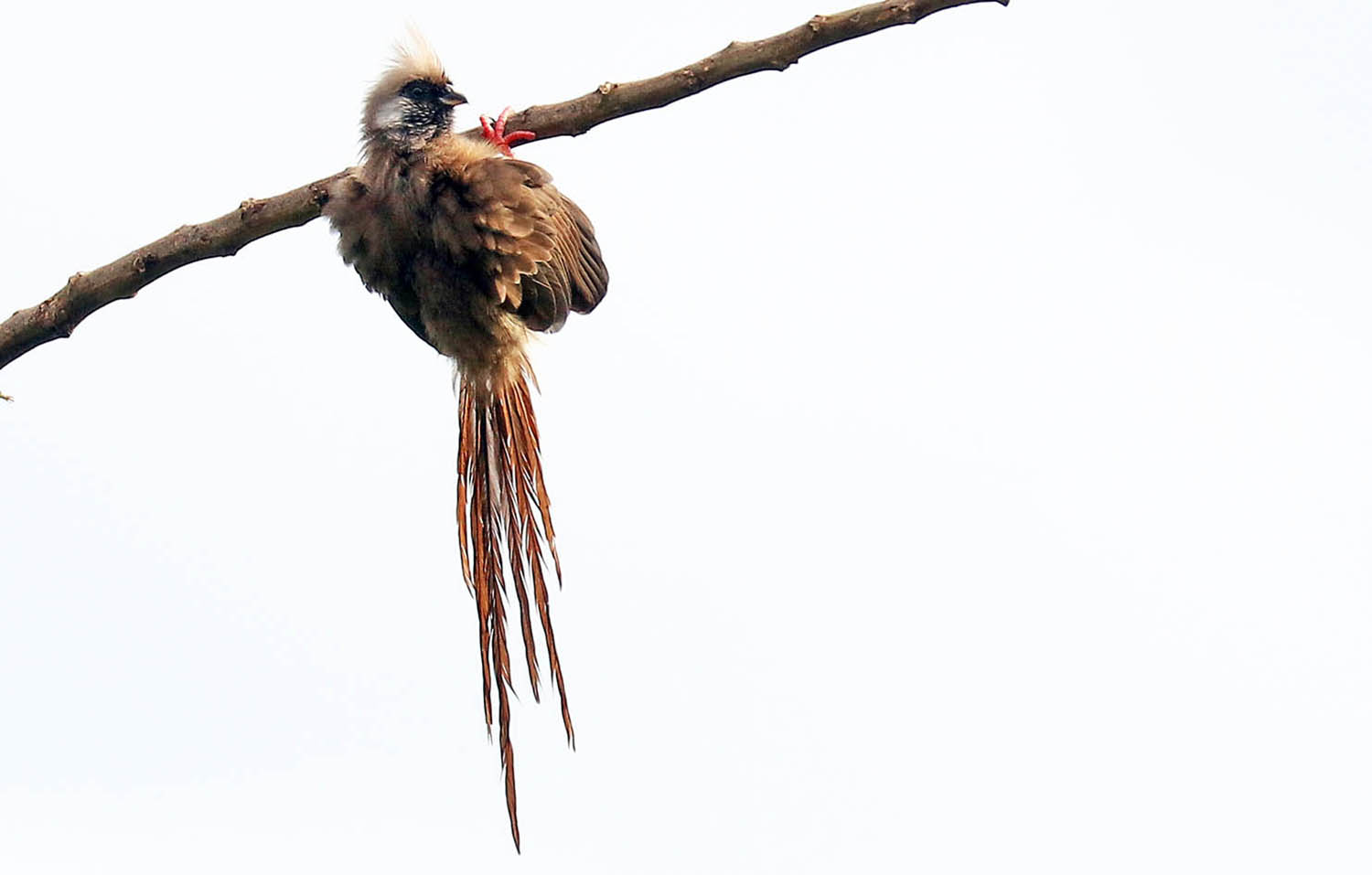 'Speckled Mousebird', (Kampala, Uganda).
'Speckled Mousebird', (Kampala, Uganda).The Hornbills of the family Bucerotidaeare an old world tropical group, found in Africa and Asia, and extending to the Solomon Islands in the east. They are large birds with huge bills, the ecological and morphological equivalent to the new world tropical Toucans. A related family called the Bucorvidae includes the 'Ground Hornbills': two species of Ground Hornbill. They are large black birds with obvious colourful throat pouches (red in male, blue in female). They have distinctive specialised feathers that act as eyelashes. Unlike most other Hornbills, these two species are carnivorous. They live in the open habitats of Africa, where the family is endemic
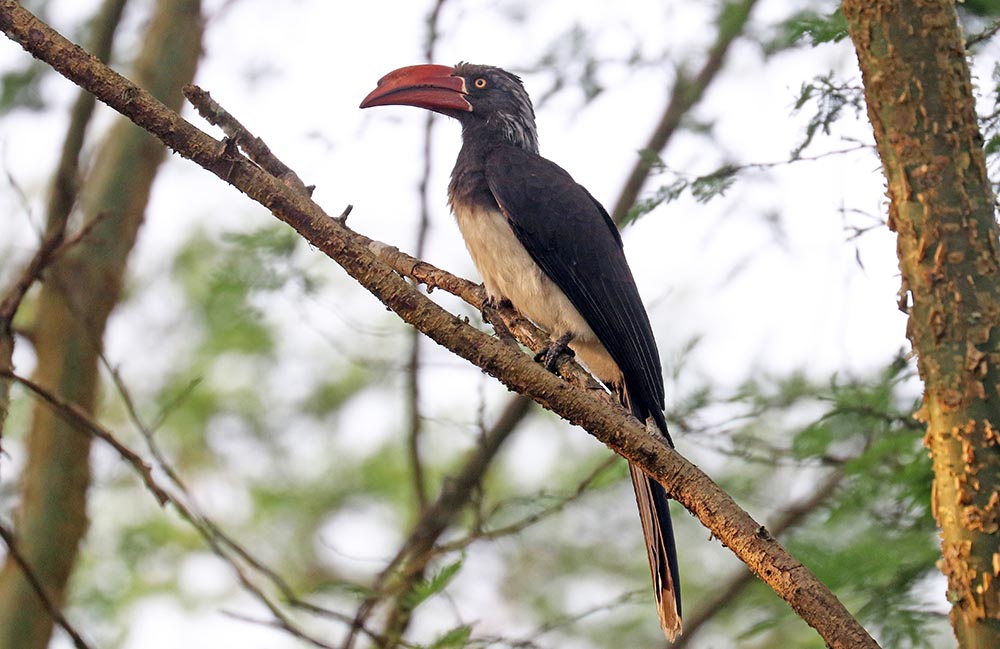 'Crowned Hornbill', (Enjojo Lodge, Uganda)
'Crowned Hornbill', (Enjojo Lodge, Uganda)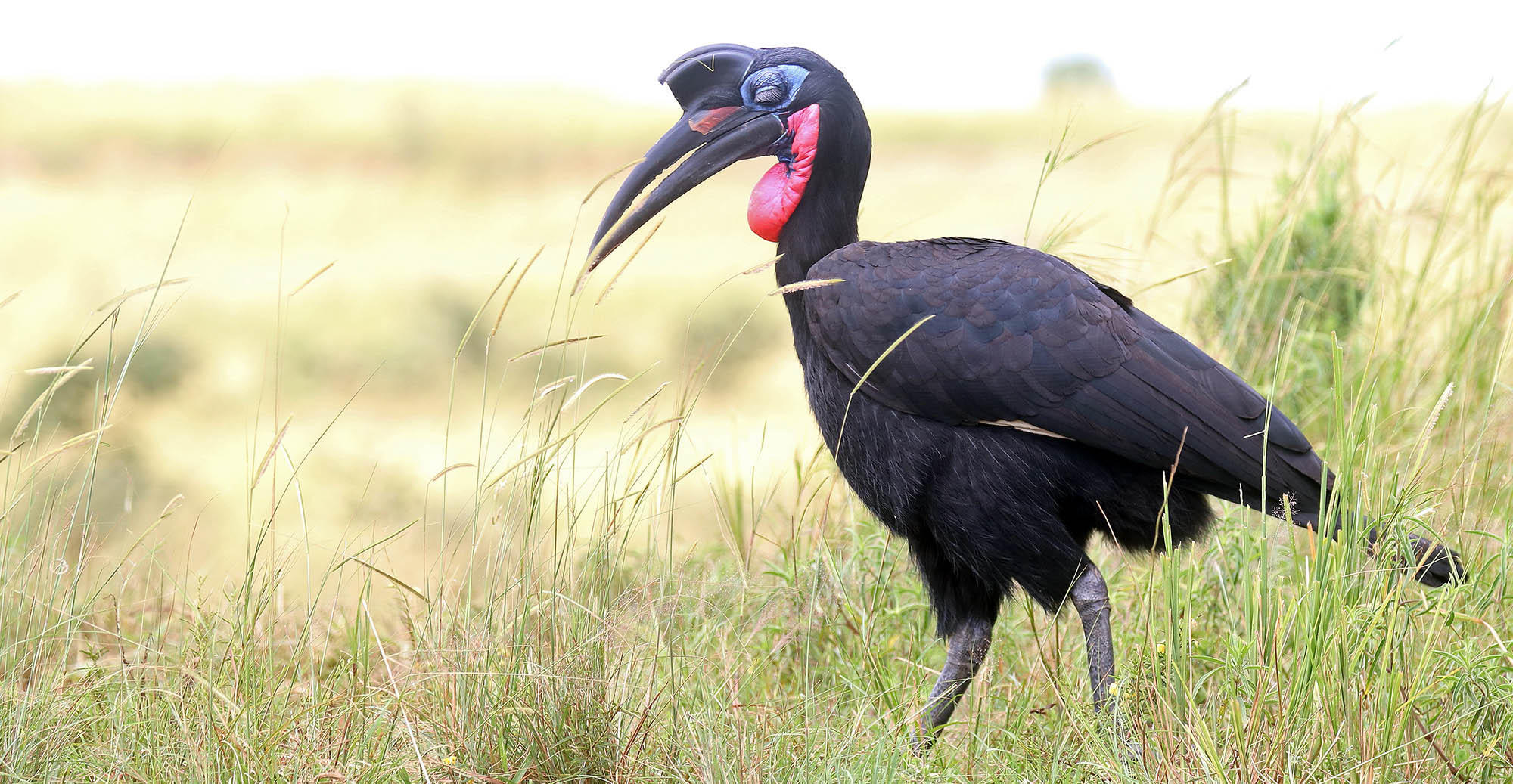 'Northern (Abyssinian) Ground Hornbill'.
'Northern (Abyssinian) Ground Hornbill'.The family Coraciidae includes the striking and colourful 'Rollers'.
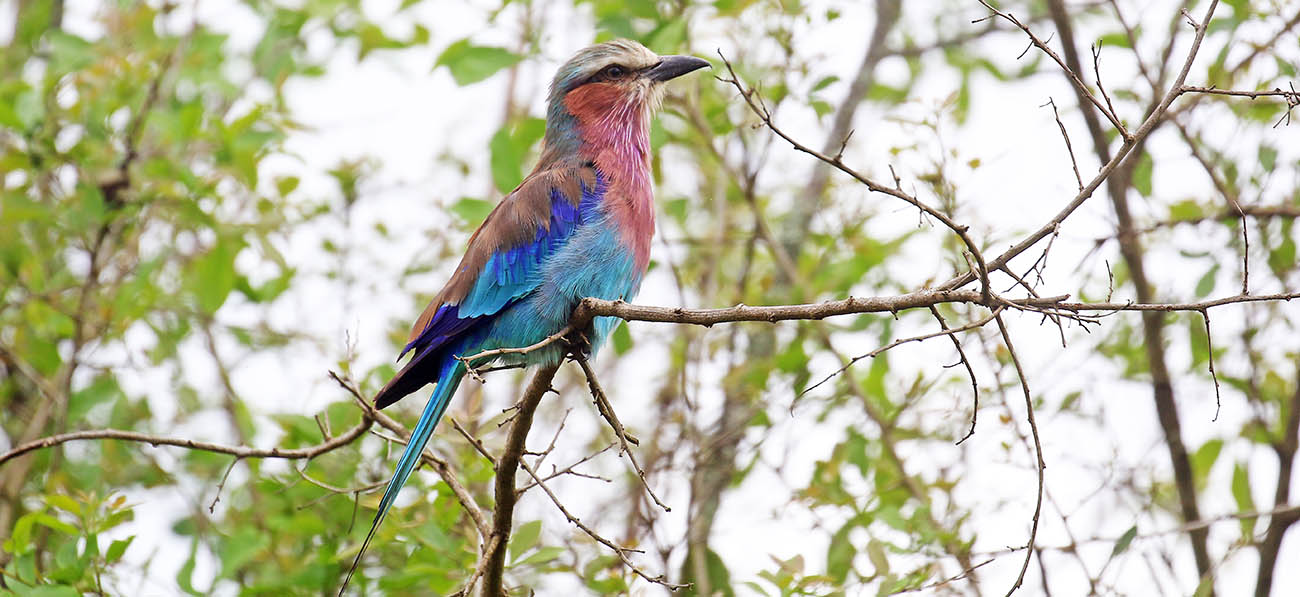 'Lilac-breasted Roller', (Lake Mburo, Uganda).
'Lilac-breasted Roller', (Lake Mburo, Uganda).One of the most diverse and pretty groups of birds in the African woodlands is the Family Meropidae, the Bee-eaters. They are often very obvious and easy birds to see as they tend to to perch on exposed branches.
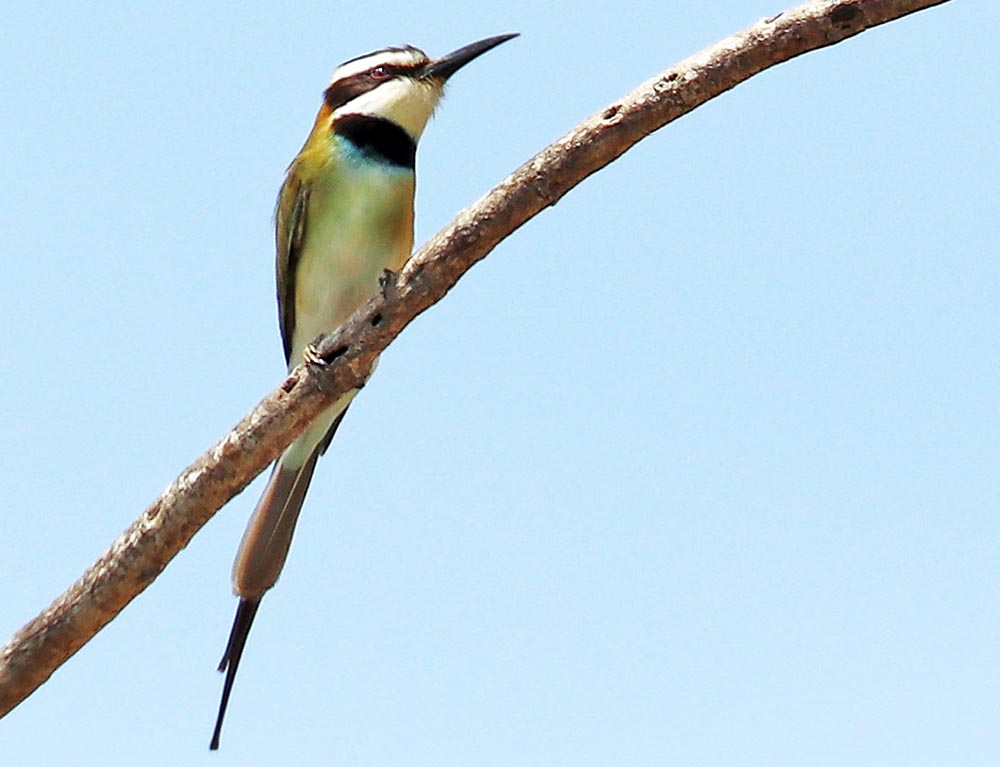 'White-throated Bee-eater' (Kilwa, Tanzania)
'White-throated Bee-eater' (Kilwa, Tanzania)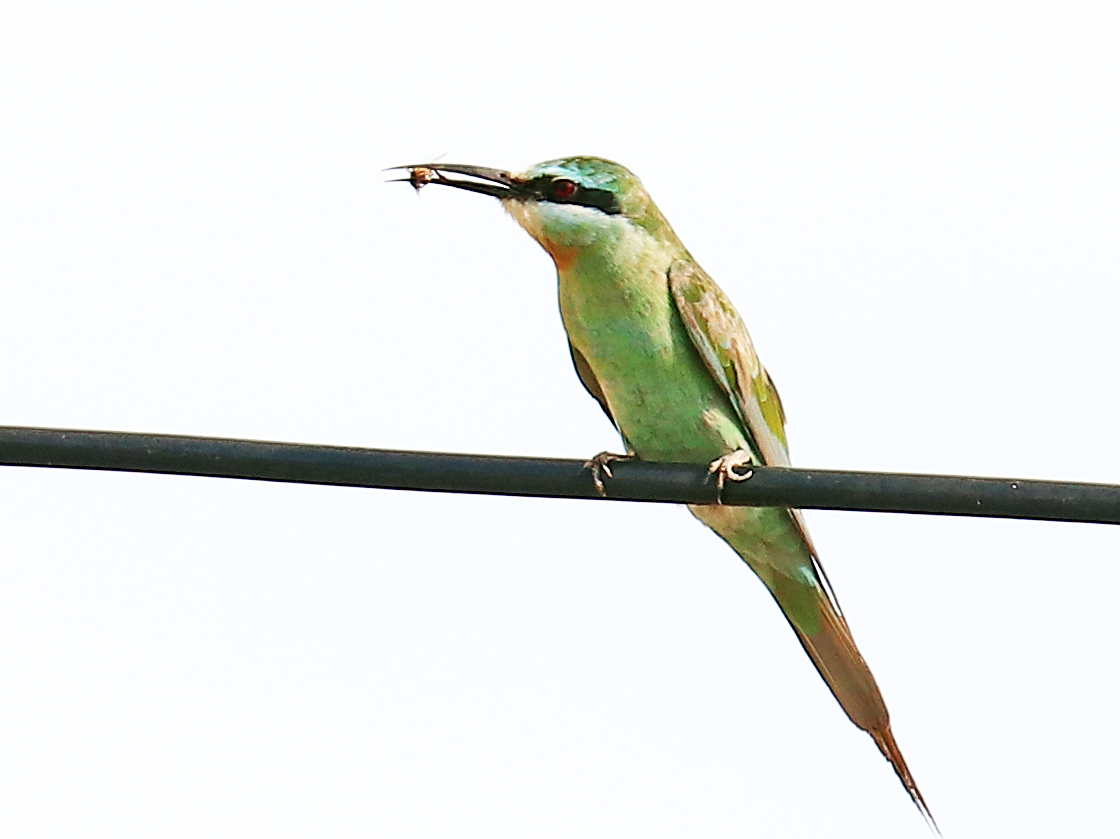 'Blue-cheeked Bee-eater'(Mozambique)
'Blue-cheeked Bee-eater'(Mozambique)There are lots of birds that will perch on larger mammals, but there is one group that specialises in it: the 'Oxpeckers'. They feed mostly on ticks, which is handy for the host mammal, as these tiny arachnids are ectoparasites. It has long been assumed Oxpeckers and their mammal rides were a good example of mutualism, where both species in the relationship benefited; but it is now considered a parasitic relationship; the birds usually eat the tick after they have fed on the mammal (when they are fat and full of nutritous yummy blood), and studies have shown no correlation between the presence of Oxpeckers and less ectoparasites.
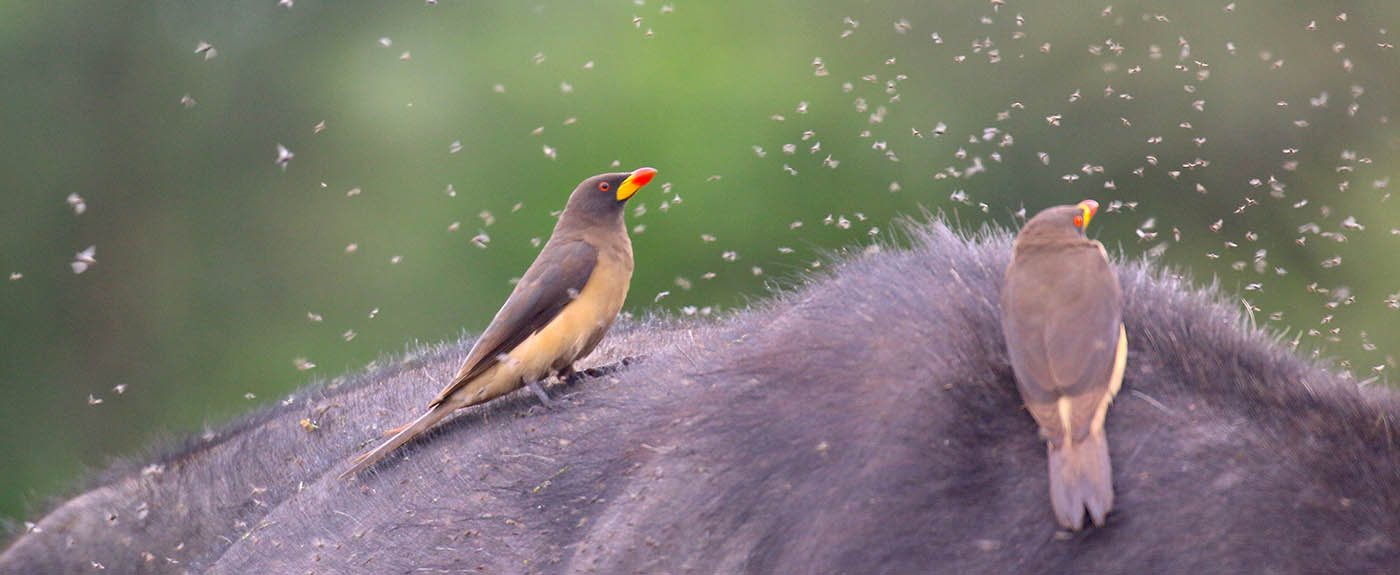 'Yellow-billed Oxpecker', (Lake Mburo, Uganda).
'Yellow-billed Oxpecker', (Lake Mburo, Uganda).One of the most stunning groups of birds in the African bush are the starlings of the family Sturnidae. Luckily, many of these starlings are easily seen around lodges and camps.
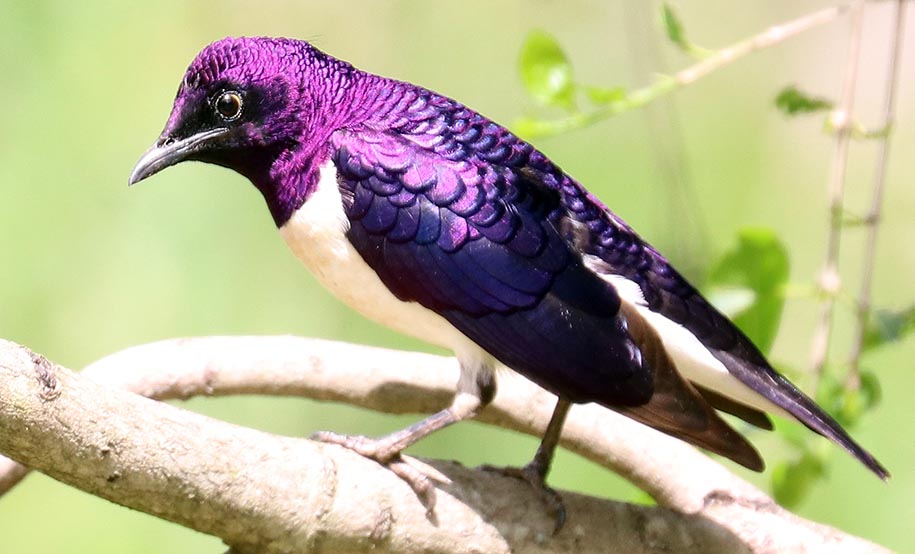 'Violet-backed Starling', (Hluhluwe-Imfolozi, South Africa).
'Violet-backed Starling', (Hluhluwe-Imfolozi, South Africa).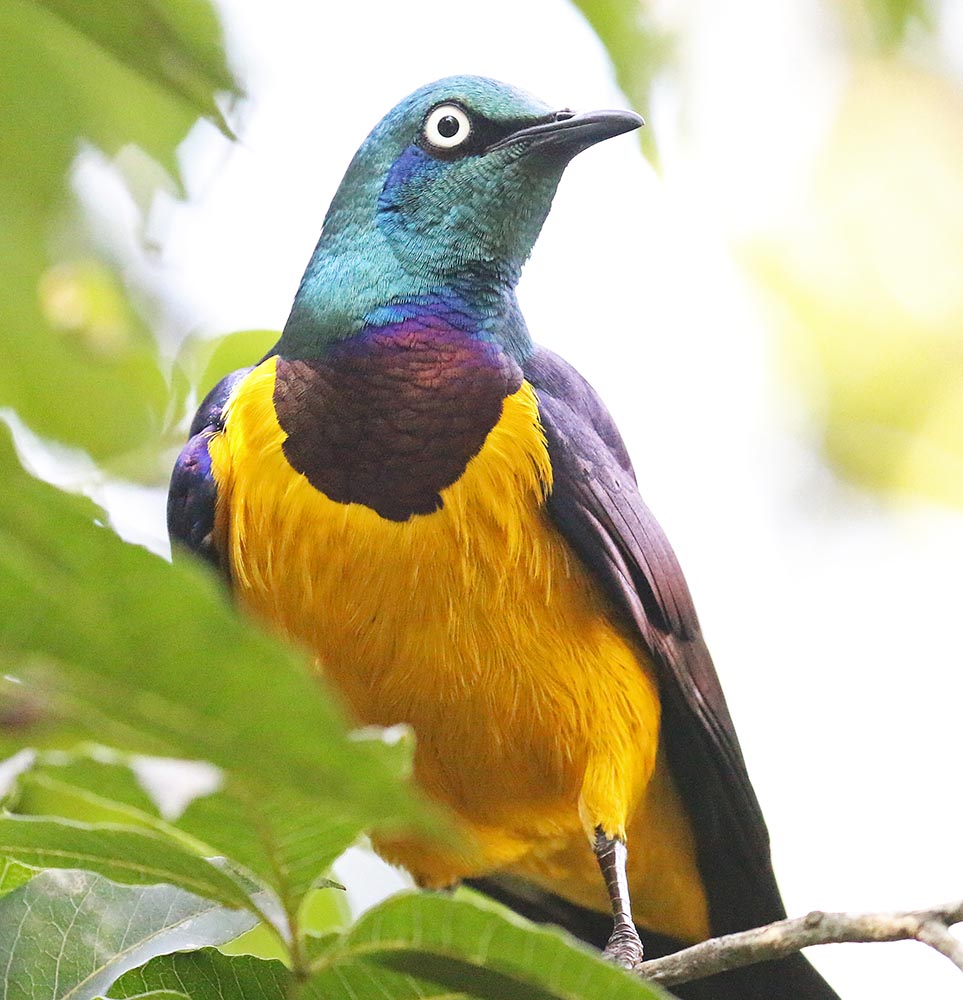 Golden-breasted Starling, (captive, Nature's Valley, South Africa)
Golden-breasted Starling, (captive, Nature's Valley, South Africa)Sunbirds are small fast birds with thin curved bills. The males are usually colourful, often iridescent. While they will feed on insects and fruit, they are mostly adapted to taking nectar from flowers. They are the Asian and African counterparts to the Honeyeaters of Australasia and the hummingbirds of the Americas; they are smaller and more delicate than the former, but generally slightly larger than the latter. Sunbirds are found throughout the Old World tropics, from Africa through Asia to Australia. Within that range they are found in various habitats, including visiting tropical gardens. The highest number of species occurs is in sub-Saharan Africa.
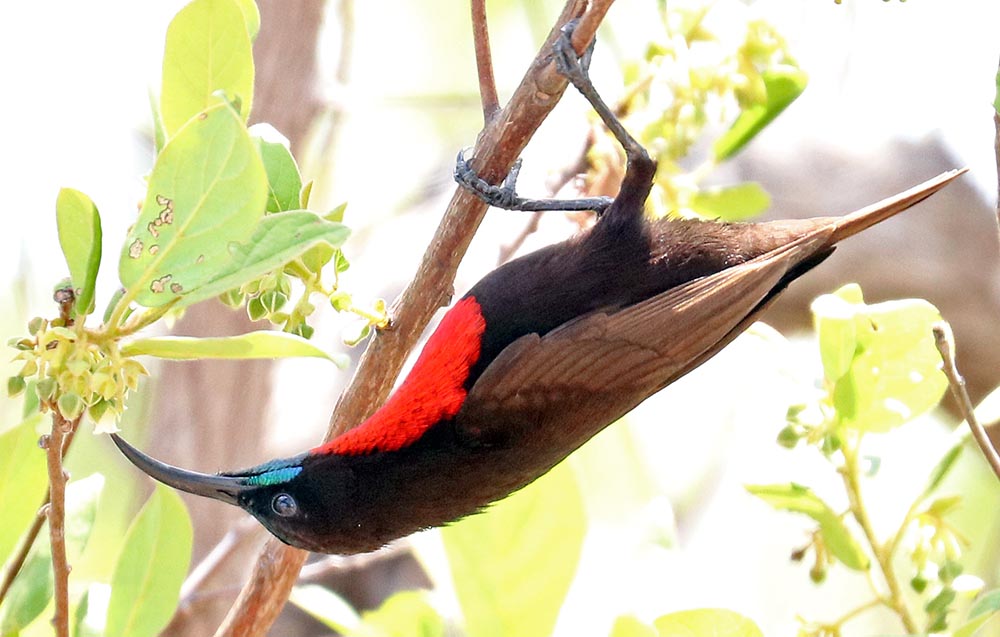 'Scarlet-chested Sunbird', (Kilwa, Tanzania).
'Scarlet-chested Sunbird', (Kilwa, Tanzania).The family Ploecidae is a large one in Africa and includes the Widowbirds and Quelea, but is dominated by the weavers. They are usually small birds, often colourful, with a conical bill. The Quela is usually seen in large flocks, and often claimed to be the most numerous bird in the world.The many species in the family called 'weavers' build woven hanging nests. Most species in this family are seed-eating birds. They are usually found in open country in sub-Saharan Africa, although there are a few species in Asia.
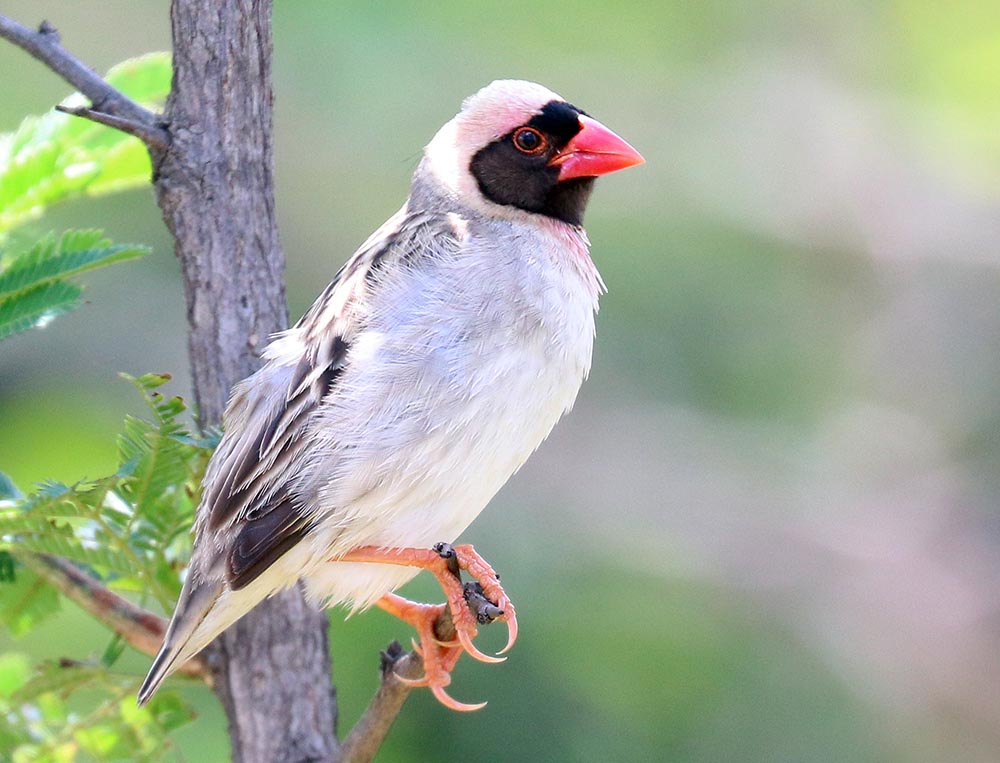 'Red-billed Quelea'.
'Red-billed Quelea'.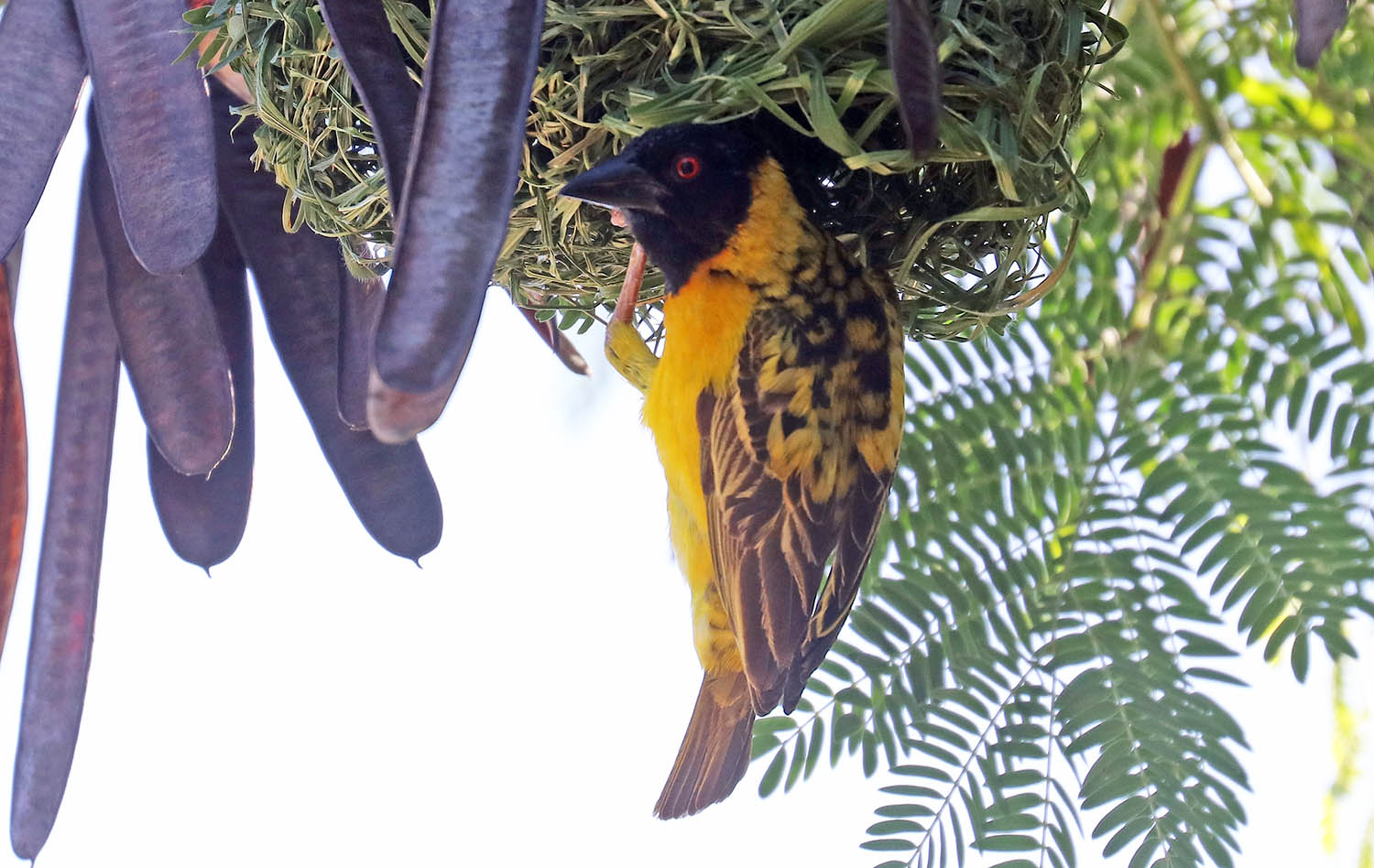 'Village Weaver', (Kisiwani, Tanzania).
'Village Weaver', (Kisiwani, Tanzania).Estrilid Finches are not related to the 'true finches', sparrows or buntings. They are mostly found in the tropical parts of the Old World, with two main radiations in Australia and Africa, particularly in the latter region, where they are most diverse.
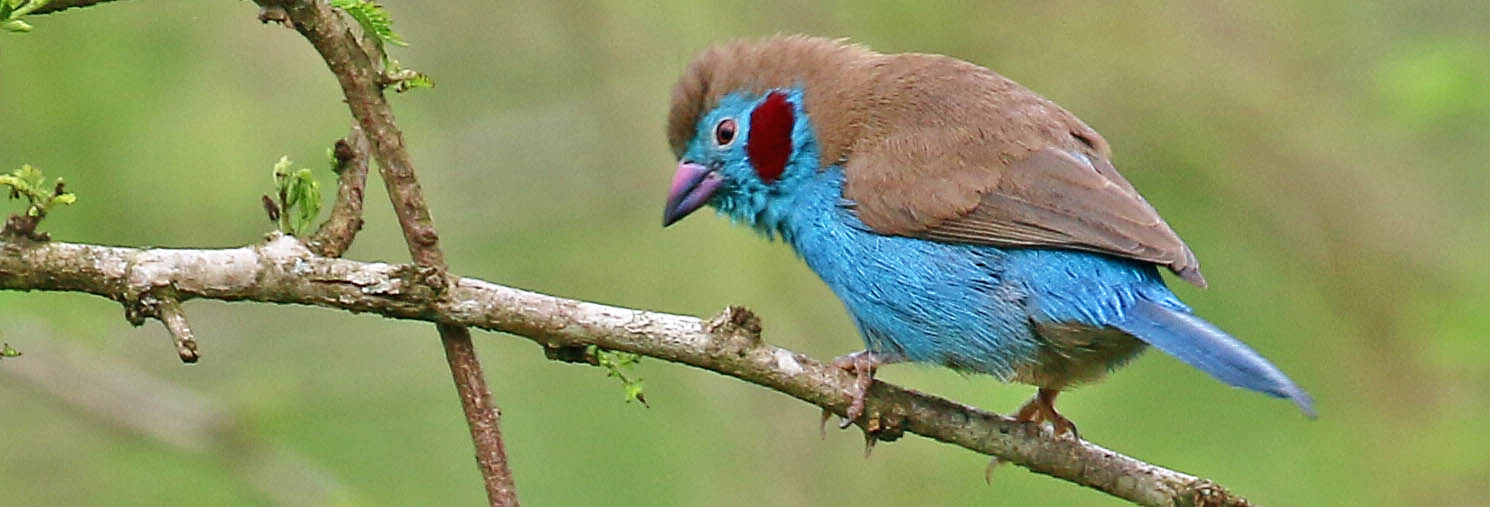 'Red-cheeked Cordonbleu'.
'Red-cheeked Cordonbleu'.The mammals are incredibly diverse and obvious across the open savanna woodlands, and they are easier to see here than in any other habitat on the planet. Of course it is difficult not to see the biggest mammal in the African bush, and the largest land animal on Earth, the African Elephant....
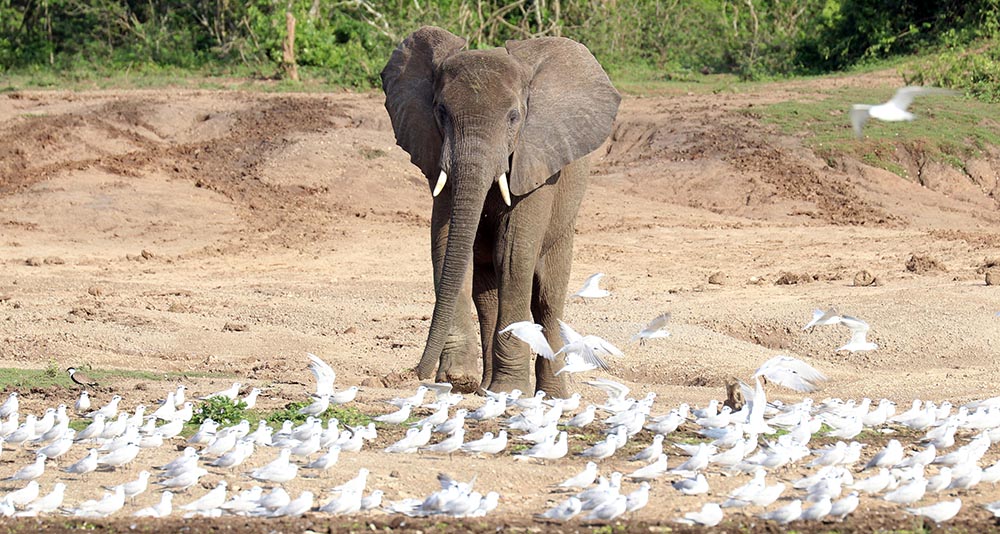 (Kazinga Channel, Uganda)
(Kazinga Channel, Uganda)The tallest mammal in the African bush, and the tallest land animal on Earth!
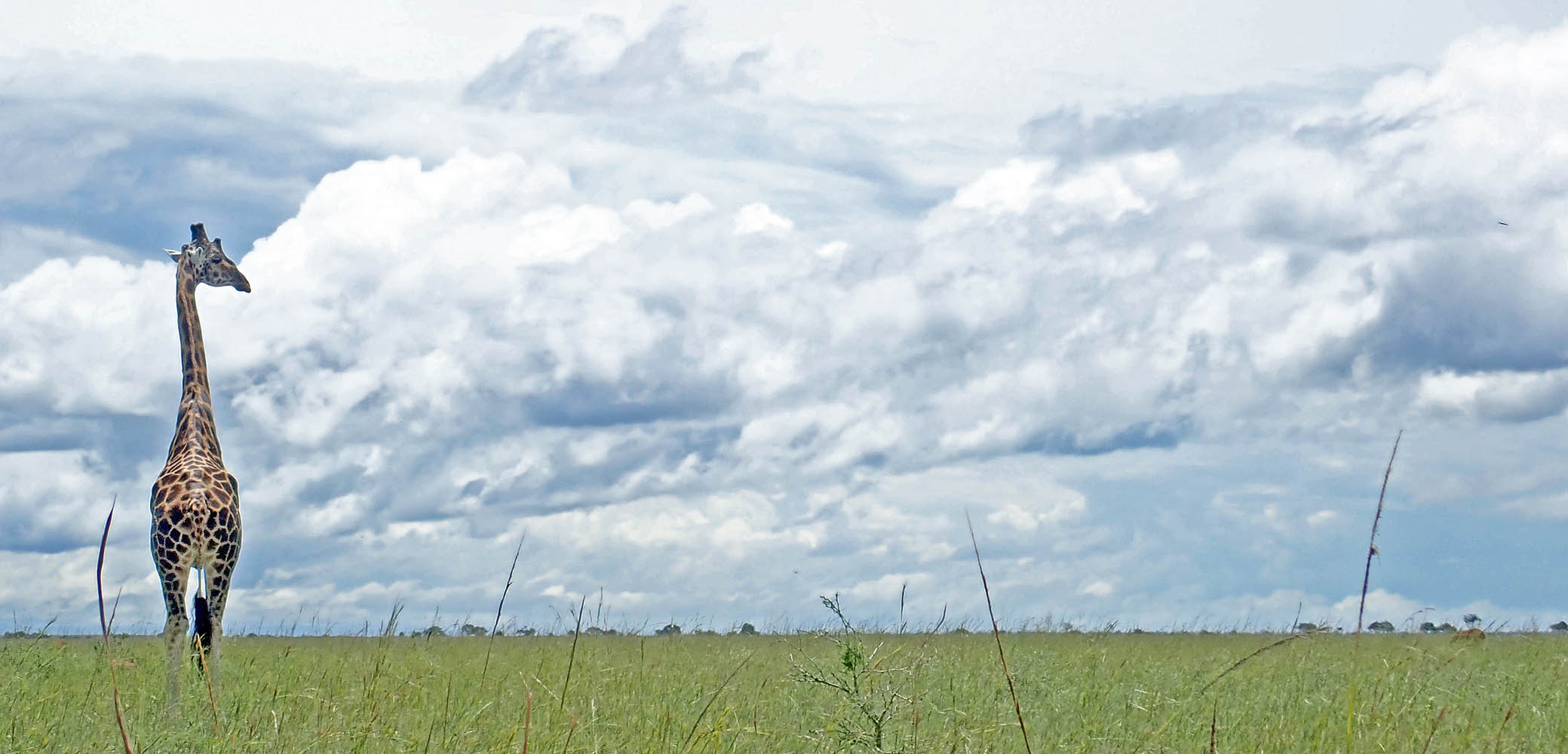 (Murchison, Uganda)
(Murchison, Uganda)The family Cercopithecidae of ''Old World Monkeys'' is represented in the African savanna by several well known species, including the Vervet Monkeys, famous for their blue balls and infamous for their food stealing!
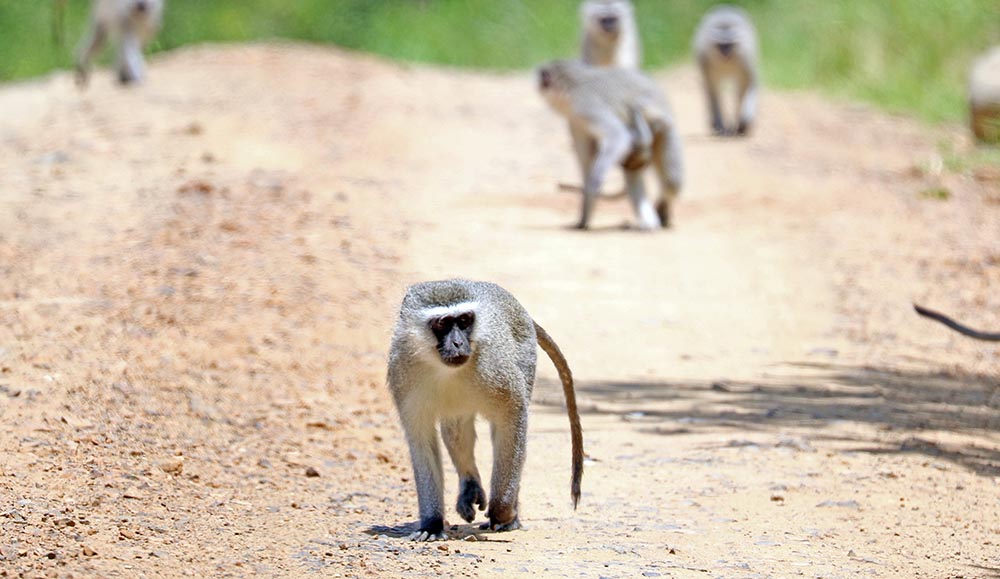
The family Bovidae include the Antelope, a group that is incredibly diverse and ecologically successful in the open African habitats.
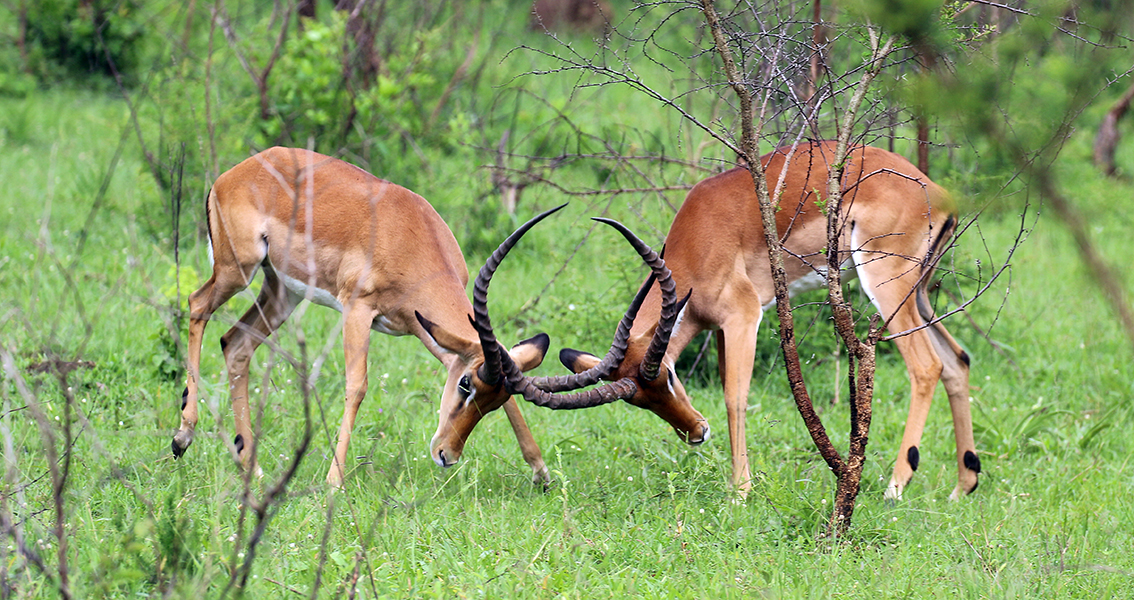
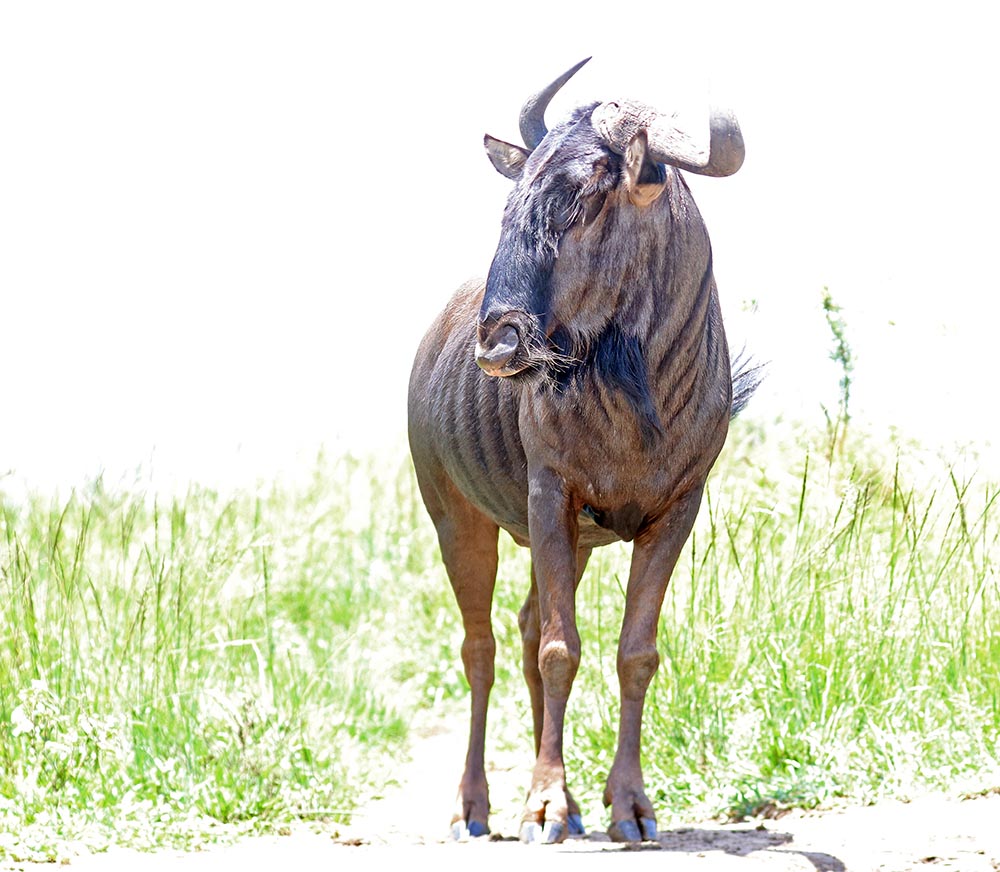 Blue Wildebeest: "hey Gnu, why the long face?" (Hluhluwe-Imfolozi, South Africa)
Blue Wildebeest: "hey Gnu, why the long face?" (Hluhluwe-Imfolozi, South Africa)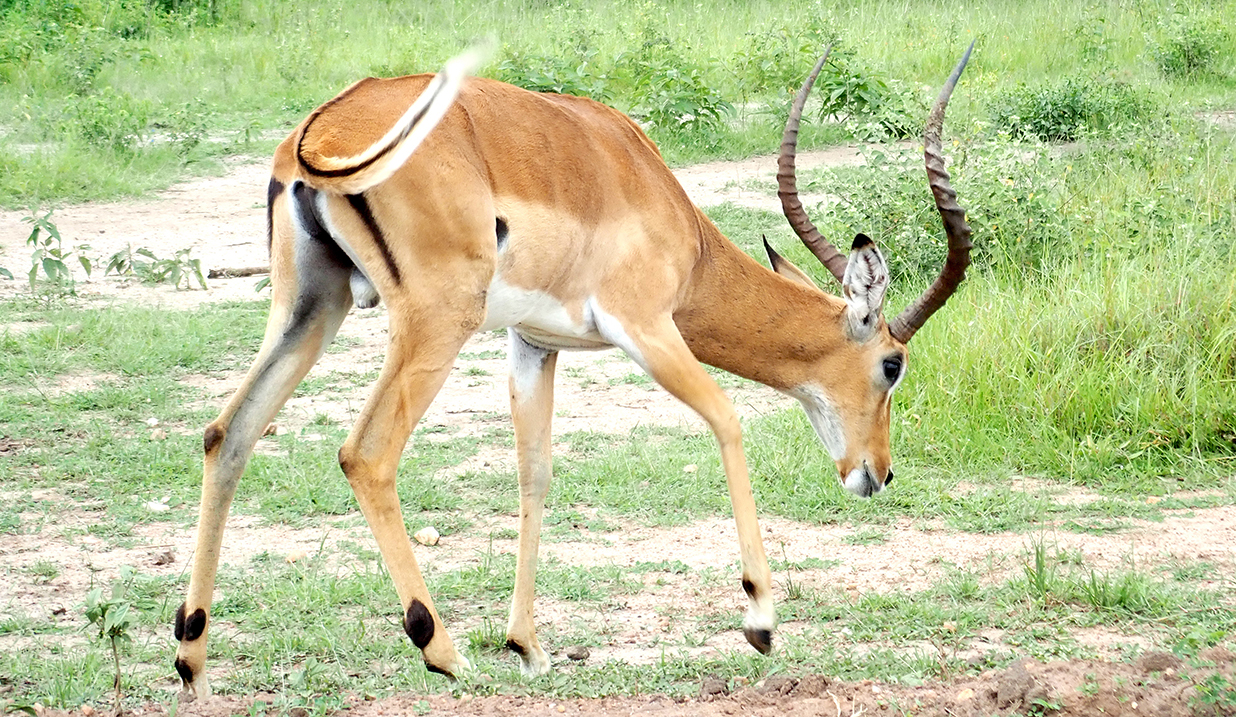 'Impala'
'Impala'The order Perissodactyla includes the 'Odd-toed Ungulates', such as horses and rhinos...
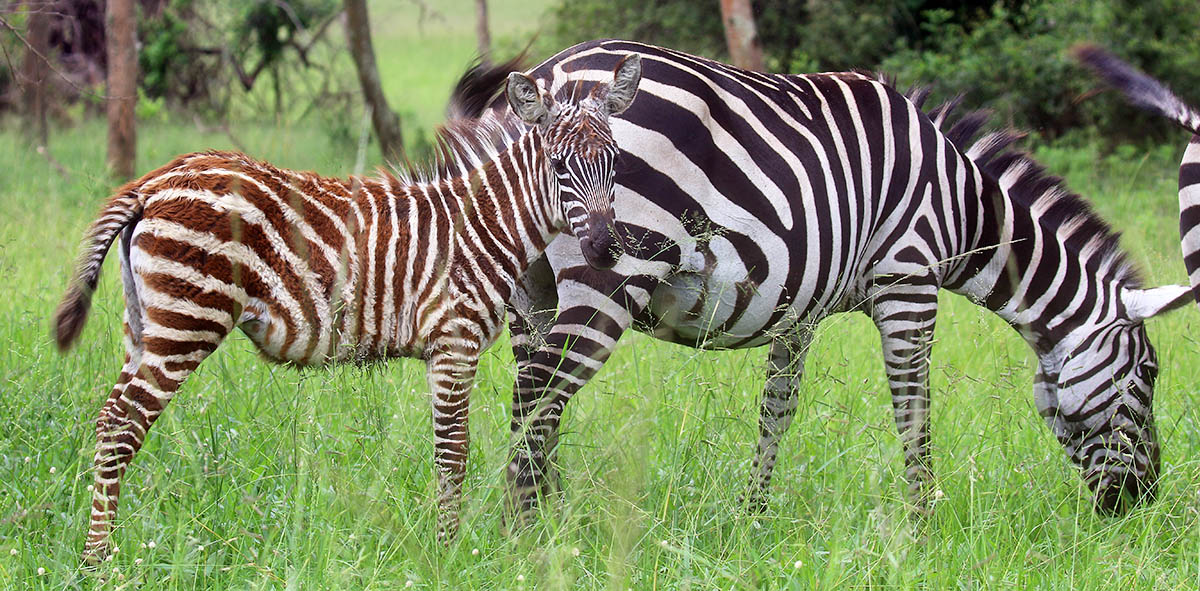 'Common Zebra', 'Plains Zebra' (Lake Mburo, Uganda)
'Common Zebra', 'Plains Zebra' (Lake Mburo, Uganda)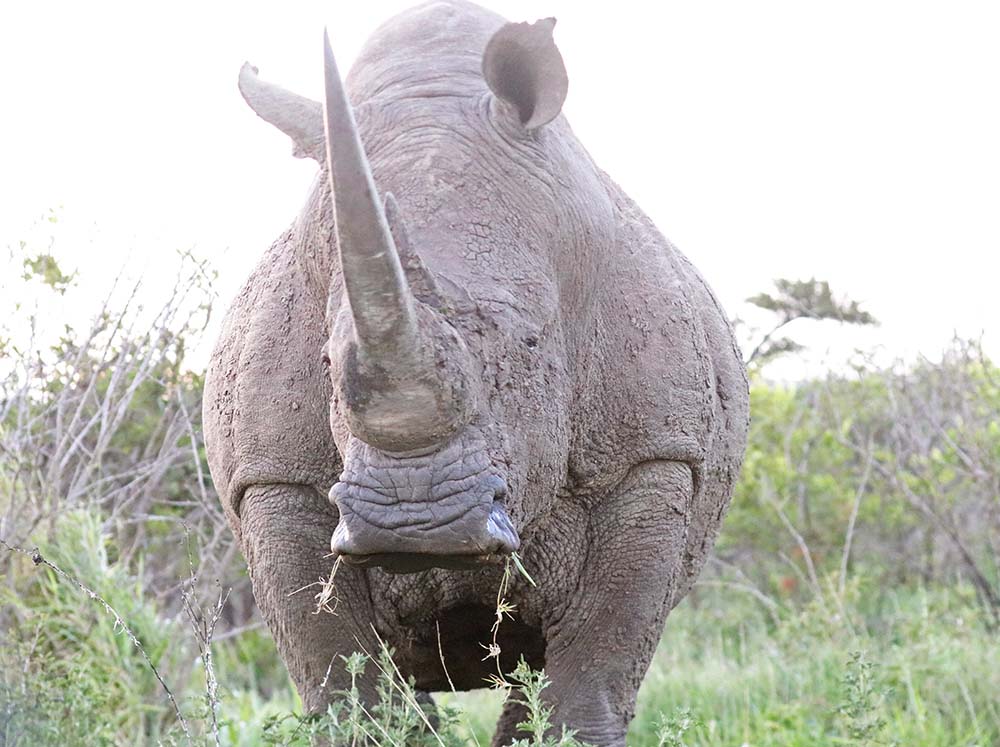 White Rhino, (Hluhluwe-Imfolozi, South Africa).
White Rhino, (Hluhluwe-Imfolozi, South Africa).The most glamorous and sought after mammals are those in the order Carnivora such as lions. These are the top predators in the African savanna.
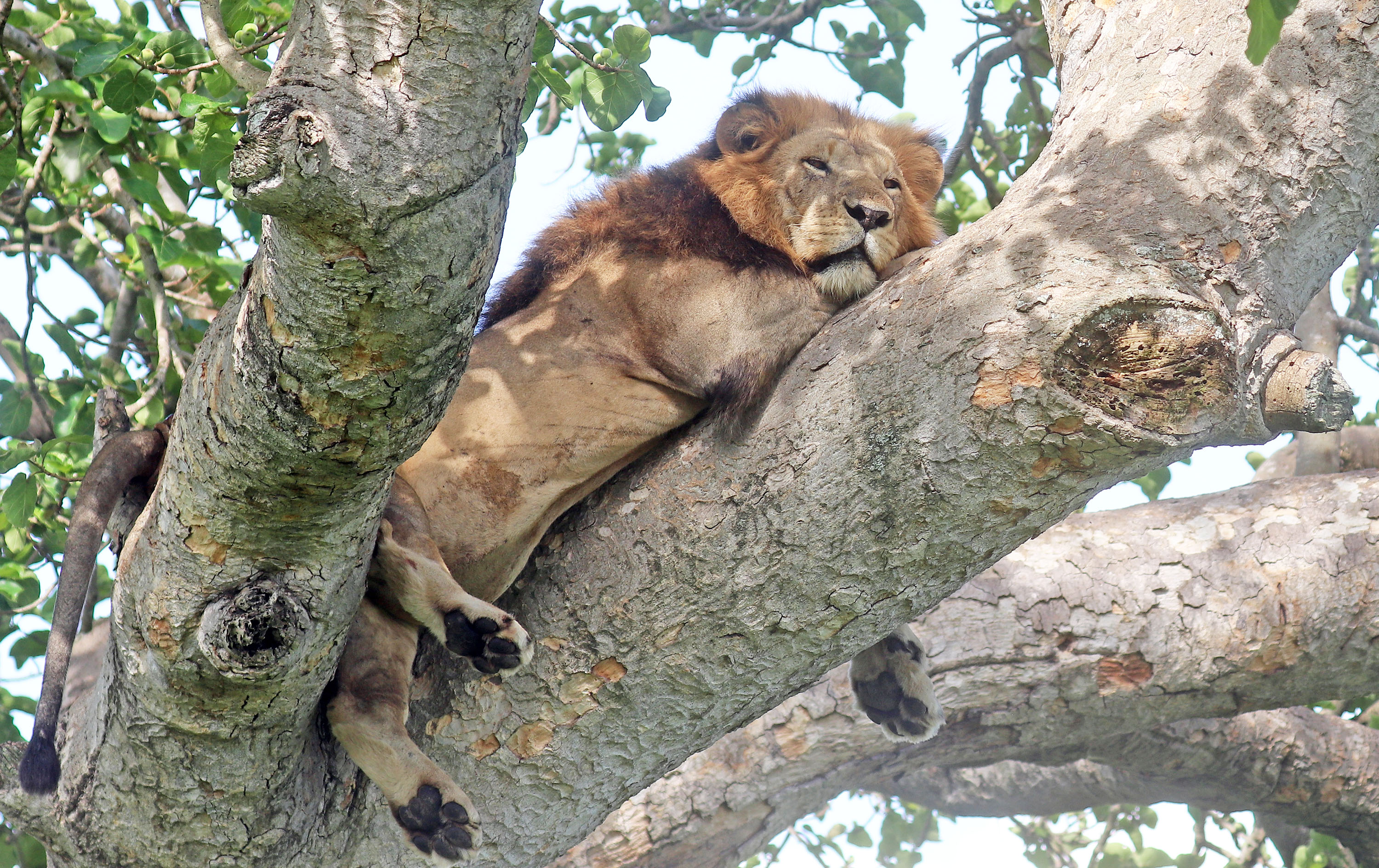
However, there is wealth of other smaller predatory species...
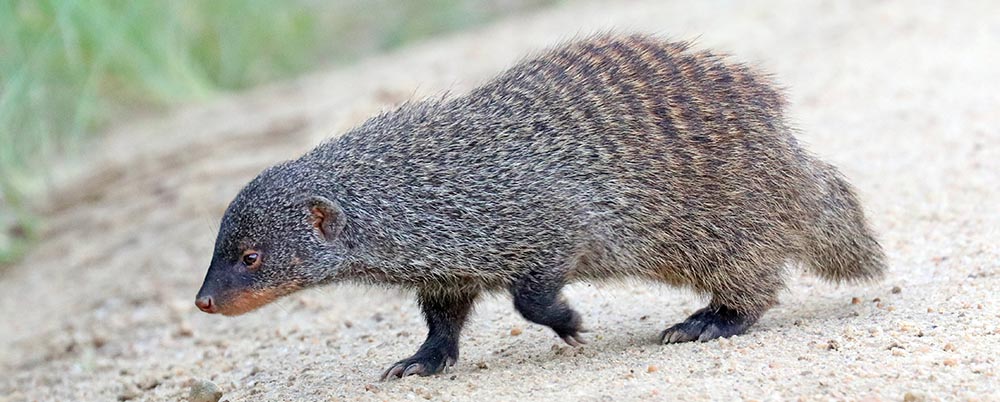 'Banded Mongoose', (Queen Elizabeth National Park, Uganda)
'Banded Mongoose', (Queen Elizabeth National Park, Uganda)Places to explore African Savanna
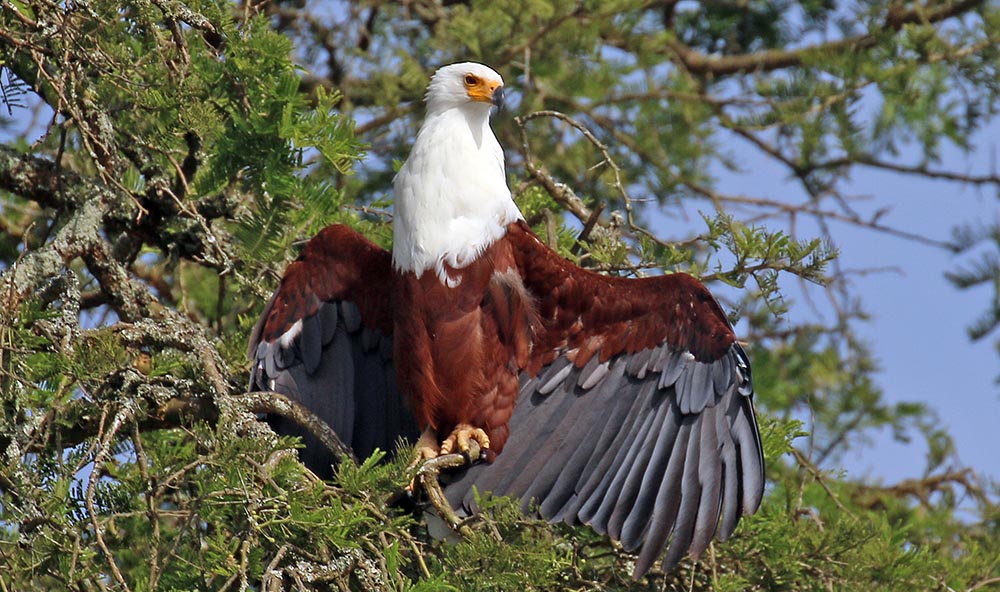 (African Fish Eagle, Lake Mburo)
(African Fish Eagle, Lake Mburo)South Africa is one of the easiest places to explore African savanna; it is easy to do by yourself in a rental car, with the continent's best infrastructure, and at the moment it is very good value. Kruger National Park is South Africa's premier national park. This park is reported to have the highest diversity of mammals in Africa. I visited the park in two different extreme times of the year; the end of the dry season, and the start of the wet season. Both contrasting times were great for different reasons. In the wet season I saw many cute baby animals, but at the end of the dry it was easier to see animals in general due to the sparser vegetation, and the animals congregating around drying waterholes. Another great wildlife spot and the oldest national park is Hluhluwe-Imfolozi National Park.
Uganda is a great country to explore, as it has a great mix of wetland. rainforest and savanna to explore. For the latter, Lake Mburo National Park is one of the closer national parks to the capital Kampala, and offers a variety of savanna species, including Uganda's only zebras and lots of birds to see. One of the highlights of Lake Mburo National Park is the boat cruise of the lake. In Uganda, there is also Queen Elizabeth National Park. The largest protected area in Uganda is Murchison Falls National Park. There is a huge range of things to do here, including safari drives and river cruises. It also has one of the best value accommodations in a national park in Uganda, the Red Chilli Hideaway, located on the river and with a great range of birds around the grounds (and the occasional Hippo wandering in at night), and a good little restaurant.



